
Home » Blog » Bluewater sailboats » The best bluewater sailboats (we analyzed 2,000 boats to find out)

The best bluewater sailboats (we analyzed 2,000 boats to find out)
By Author Fiona McGlynn
Posted on Last updated: May 16, 2023
We analyzed two-thousand bluewater sailboats to bring you a list of proven offshore designs
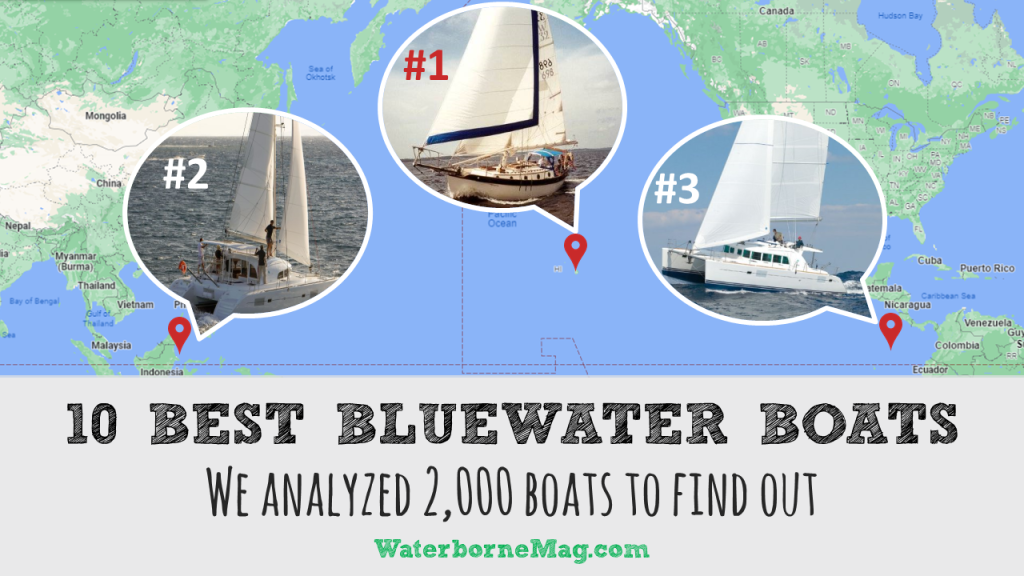
What are the best bluewater sailboats?
This was a question we asked a lot of experienced cruisers when we decided to sail across the Pacific. We needed a boat after all, and we wanted to buy the best bluewater sailboat we could afford.
We heard a lot of strong opinions.
Some sailors thought it was reckless to go offshore in any boat that didn’t have a full keel.
Others prioritized performance, and wouldn’t dream of going anywhere in a slow boat like the Westsail 32 (a.k.a. a “Wet Snail 32”).
Opinions like these left us feeling confused like we had to choose between safety and performance.
If we learned anything from these conversations, it’s that what makes a bluewater boat is a hotly debated topic!
However, there’s a way to cut through all the opinions and get to the bottom of it. The solution is….
We analyzed just under 2,000 boats embarking on ocean crossings (over a 12 year time period) and came up with a list of the ten best bluewater sailboats.
Where did we get our data?
The data for our best bluewater sailboats list comes from 12 years of entries in the Pacific Puddle Jump (PPJ), an annual cross-Pacific rally. We took part in 2017 and had a ball!
You can read about the methodology we used to analyze this data at the bottom of the post.
What do we mean by “best”?
We know, that word is overused on the internet!
Simply, based on our data set, these were the most common makes and models entered in the PPJ cross-Pacific rally. There were at least 10 PPJ rally entries for every make of boat on our top 10 list.
So, these boats are 100% good to go?
No! A bluewater boat isn’t necessarily a seaworthy boat. Almost every cruiser we know made substantial repairs and additions to get their offshore boat ready, adding watermakers , life rafts, solar panels, and more.
Also, you should always have a boat inspected by a professional and accredited marine surveyor before buying it or taking it offshore.
But my bluewater baby boat isn’t on this list!?
There are hundreds of excellent bluewater yachts that are not on this list. For instance, we sailed across the Pacific in a Dufour 35, which didn’t even come close to making our top 10 list.
Choosing the right boat is very much an individual journey.
Where can I find these bluewater boats for sale?
We recognize that a top 10 list won’t get you very far if you’re shopping for a bluewater boat (especially if you’re looking in the used market).
So, to help you find your perfect boat, we’re going to create a big list of bluewater boats that you can use to refine your search on Yachtworld, Craigslist, or any other places to buy a used boat .
Sign up for our newsletter to get our big list of bluewater boats list as soon as it comes out.
We’re also working on a series of posts by size class. For example, if you’re looking for a smaller boat, you can narrow it down to the best bluewater sailboats under 40 feet .
Takeaways from our analysis
There were no big surprises on an individual boat level. All of these makes are considered good cruisers, some of them are even best-selling designs! However, there were a few things that caught our eye.
“Go simple, go small, go now” still holds water
We were thrilled to see the smallest boat in our roundup at the very top of the list! Westsail 32 owners can take pride in their small but mighty yachts (and ignore all those snail-sayers).
While undoubtedly there’s been a trend towards bigger bluewater cruisers in recent years, small cruising sailboats seem to be holding their own. 60% of the monohulls on this list were under 40 feet (if you count the Valiant 40 which sneaks just under at 39.92 feet).
Cat got our tongue
So, we knew catamarans were a thing, but we didn’t fully appreciate HOW popular they’d become!
50% of our top 10 bluewater boat list consists of catamarans—a good fact to toss out the next time you’re trying to garner a happy hour invite on the party boat next door (which will undoubtedly be a catamaran).
Still got it!
We’ve got good news for all you good old boat lovers! 60% of the boats on our list were first built before 2000.
While these older models are less performance-oriented than modern designs, cruisers value these boats for their ability to stand up to rough seas and heavy weather. It just goes to show that solid bones and classic looks never go out of style.
Alright, without further ado, let’s dive into our list of the 10 best bluewater boats!
The 10 best bluewater boats
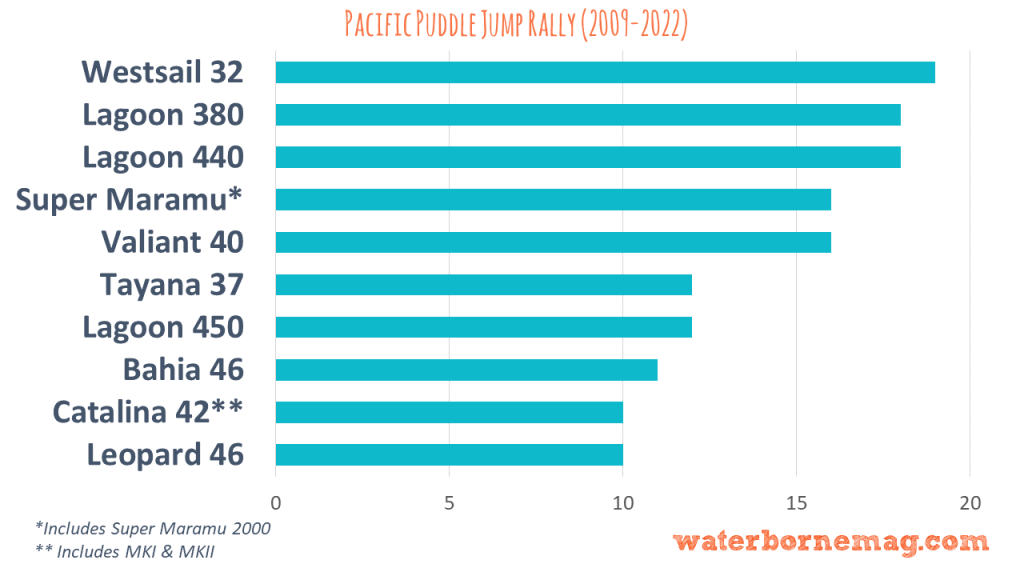
1. Westsail 32
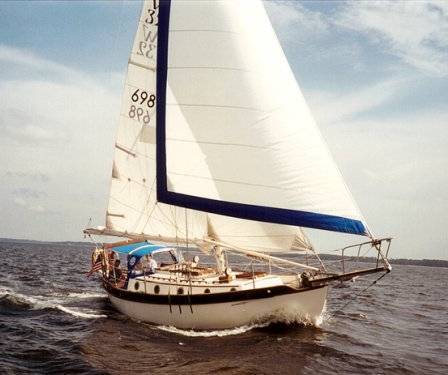
The Westsail 32 is one of the most iconic bluewater cruisers and 19 have set out to cross the Pacific in the PPJ rally since 2009.
In 1973, this small cruising sailboat garnered a 4-page spread in Time magazine. The article inspired many Americans to set sail and the Westsail 32, with its double-ender design, set the standard for what a real bluewater cruiser should look like.
There were approximately 830 built between 1971 and 1980.
This small boat has taken sailors on ocean crossings and circumnavigations. Though considered “slow” by some, the heavily-built Westsail 32 has developed a loyal following for her other excellent offshore cruising characteristics.
If you’re interested in small bluewater sailboats, check out our post on the best small sailboats for sailing around the world .
2. Lagoon 380
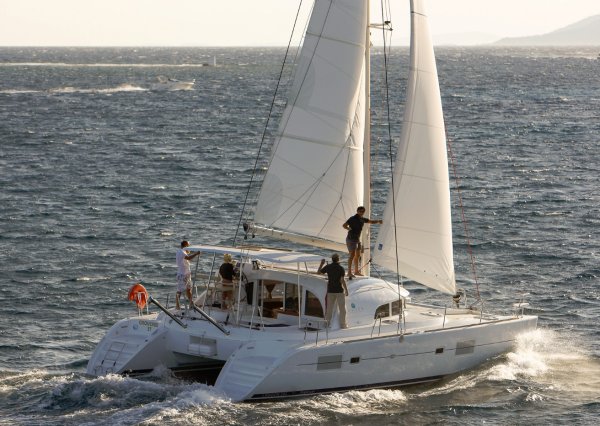
The Lagoon 380 is a reliable, solidly built catamaran and considered roomy for its size. We counted 18 of them in our data set. With over 800 boats built , it may be one of the best-selling catamarans in the world. Like the other boats on this list, the Lagoon 380 has proven itself on long passages and ocean crossings, winning it many loyal fans.
3. Lagoon 440
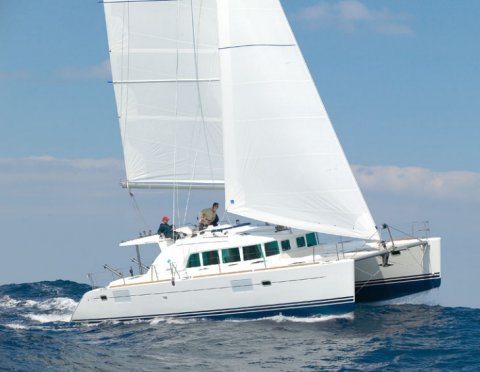
18 Lagoon 440s have set out to cross the Pacific in the PPJ rally since 2009.
Why leave the comforts of home, when you can take them with you? The Lagoon 440 is a luxurious long-range cruiser, offering beautiful wood joinery, spacious accommodations, and a deluxe galley. Oh, and you have the option of an electric boat motor !
SAIL and Sailing Magazine have both done in-depth reviews of the Lagoon 440 if you want to learn more.
4. Amel Super Maramu (incl. SM 2000)
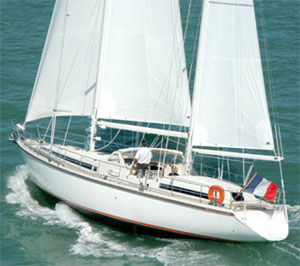
If you follow the adventures of SV Delos on YouTube, you probably know that the star of the show (SV Delos— in case the title didn’t give it away ) is an Amel Super Maramu. These classic bluewater sailboats can be found all over the world, proof they can go the distance.
We counted 16 Amel Super Maramus and Super Maramu 2000s in our list of PPJ entries.
Ready to join the cult of Amel? Read more about the iconic brand in Yachting World.
5. Valiant 40
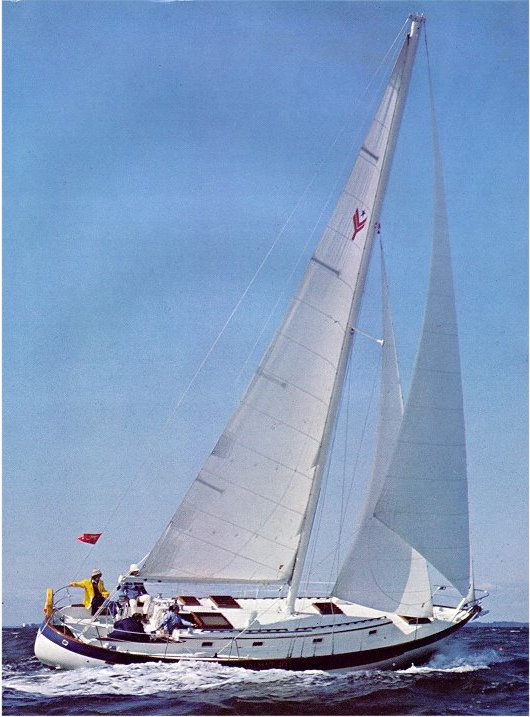
When I interviewed legendary yacht designer, Bob Perry, for Good Old Boat in 2019, he told me that the Valiant 40 was one of the boats that most defined him and marked the real start of his career.
At the time, heavy displacement cruisers were considered sluggish and slow, especially in light winds.
Perry’s innovation with the Valiant 40 was to combine a classic double ender above the waterline, with an IOR racing hull shape below the waterline. The result was the first “performance cruiser”, a blockbuster hit, with over 200 boats built in the 1970s.
It’s no surprise we counted 16 Valiant 40s in our data set.
Cruising World magazine dubbed it “a fast, comfortable, and safe cruising yacht,” and there’s no doubt it’s covered some serious nautical miles.
It’s worth noting that there were blistering problems with hull numbers 120-249 (boats built between 1976 and 1981). Later models did not have this problem. Despite the blistering issues, the Valiant 40 remains one of the most highly thought of bluewater designs.
6. TAYANA 37
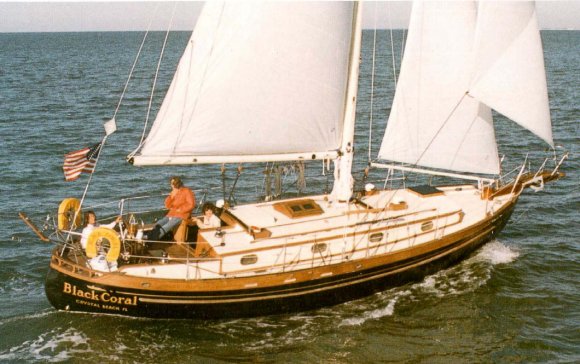
The Tayana 37 is another hugely popular Perry design. The first boat rolled off the production line in 1976 and since then, nearly 600 boats have been built. Beautiful classic lines and a proven track record have won the Tayana 37 a devoted following of offshore enthusiasts.
12 Tayana 37s have set out to cross the Pacific in the PPJ rally since 2009. Read more about the Tayana 37 in this Practical Sailor review .
7. Lagoon 450
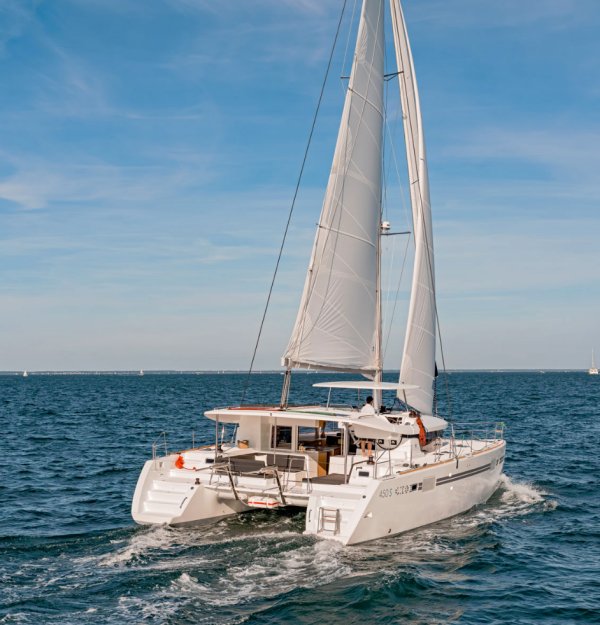
If this list is starting to sound like a paid advertisement, I swear we’re not on Lagoon’s payroll! This is the third Lagoon on our list, but the data doesn’t lie. Lagoon is making some of the best cruising sailboats.
The 450 has been a hot seller for Lagoon, with over 800 built since its launch in 2014. While not a performance cat, the Lagoon 450 travels at a reasonable speed and is brimming with luxury amenities.
At least 12 owners in the PPJ rally chose the Lagoon 450 to take them across the Pacific. It’s no wonder SAIL had so many good things to say about it.
8. Fountaine Pajot Bahia 46
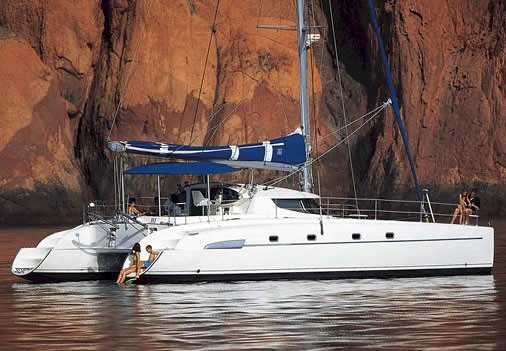
There were 11 Fountaine Pajot Bahia 46s in our data set.
Fountaine Pajot released the Bahia 46 in 1997, a sleek design for traveling long distances. Its generously-sized water and fuel tanks along with ample storage for cruising gear are a real plus for the self-sufficient sailor.
According to Cruising World , “Cruising-cat aficionados should put the Bahia 46 on their “must-see” list.”
9. Catalina 42 (MKI, MKII)
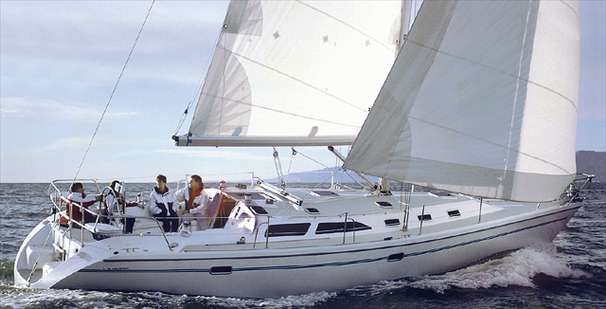
10 Catalina 42s (MKI and MKII) have set out to cross the Pacific in the PPJ rally since 2009.
The Catalina 42 was designed under the guidance of the legendary yacht designer and Catalina’s chief engineer, Gerry Douglas.
One of Catalina’s philosophies is to offer “as much boat for the money as possible,” and the Catalina 42 is no exception. According to Practical Sailor , Catalina aims to price its boats 15% to 20% below major production boats like Hunter and Beneteau.
Practical Sailor has a great in-depth review of the Catalina 42 .
10. Leopard 46
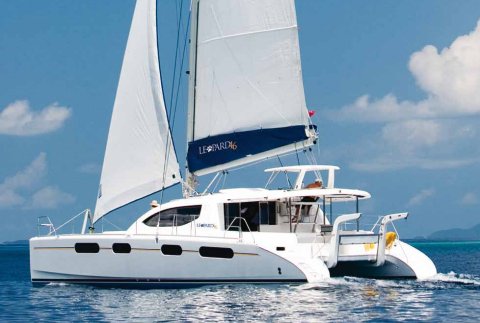
Since 2009, 10 Leopard 46s have embarked on Pacific crossings in the PPJ rally.
Leopards have won legions of fans for their high build quality, robust engineering, and excellent performance.
The Leopard 46 also boasts something of a racing pedigree. It was built in South Africa by Robertson and Caine and designed by Gino Morelli and Pete Melvin, who came up with the record-breaking catamaran Playstation / Cheyenne 125 .
Read more about the Leopard 46 in this Cruising World review .
Methodology
What the data is and isn’t.
The PPJ data was a real boon because it reflects a wide range of cruising boats: small, big, old, new, expensive, and affordable. We think this may be because the PPJ is a very financially accessible rally—the standard entry cost is $125 or $100 if you’re under 35 (age or boat length!).
We did look at data from other (pricier) rallies but found that the results skewed towards more expensive boats.
Needless to say, the data we used is just a sample of the bluewater boats that crossed the Pacific over the last 10+ years. Many cruisers cross oceans without participating in a rally!
Entries vs. completions
The data we used is a list of the PPJ entries, not necessarily the boats that completed the rally. In instances where we saw the same boat entered multiple years in a row, we assumed they’d postponed their crossing and deleted all but the latest entry to avoid double counting.
Boat make variations
The world of boat building and naming can get pretty complicated. Sometimes a manufacturer changes a boat’s name a year or two into production, other times the name remains the same but the boat undergoes a dramatic update.
For the most part, we’ve used SailboatData.com’s classification system (if they list the boats separately, then we have also), except where there are two separately listed models that have the same LOA, beam, and displacement.
Fiona McGlynn is an award-winning boating writer who created Waterborne as a place to learn about living aboard and traveling the world by sailboat. She has written for boating magazines including BoatUS, SAIL, Cruising World, and Good Old Boat. She’s also a contributing editor at Good Old Boat and BoatUS Magazine. In 2017, Fiona and her husband completed a 3-year, 13,000-mile voyage from Vancouver to Mexico to Australia on their 35-foot sailboat.
Terms and Conditions - Privacy Policy
7 Legendary Solo Bluewater Sailboats Worth Considering
When setting out to explore the open seas solo, you'll have to choose the right bluewater sailboat from so very many available options. The perfect boat for sailing single-handed is one that's not only safe and seaworthy, but also easy to handle on your own. In this article, we've handpicked the top 7 legendary solo bluewater sailboats worth considering for their excellent track records.
The most legendary solo bluewater sailboats are the Contessa 32, Westsail 32, Hallberg-Rassy 42F, Pacific Seacraft 37, Island Packet 38, Tayana 42, and Amel 54. These boats have it all: from robust designs to a world-renowned reputation for performance and reliability. They are known for their seaworthiness, durability, and comfort.
We understand the importance of balancing comfort and performance when spending prolonged periods at sea. Each of these sailboats has been proven to provide a harmonious blend of these attributes. Let's get to know them more below.
- Solo bluewater sailboats are designed to be sailed by a single person, making them ideal for solo circumnavigation or long-distance cruising.
- You can get the Contessa 32 and Westsail 32 for as little as $30,000.
- The maintenance and repair costs of the seven boats range from $5,000 to $50,000 per year.
- Marina fees and insurance can range from $5,000 to $20,000 per year.
- Factor in upgrades and equipment costs that can reach up to $100,000.
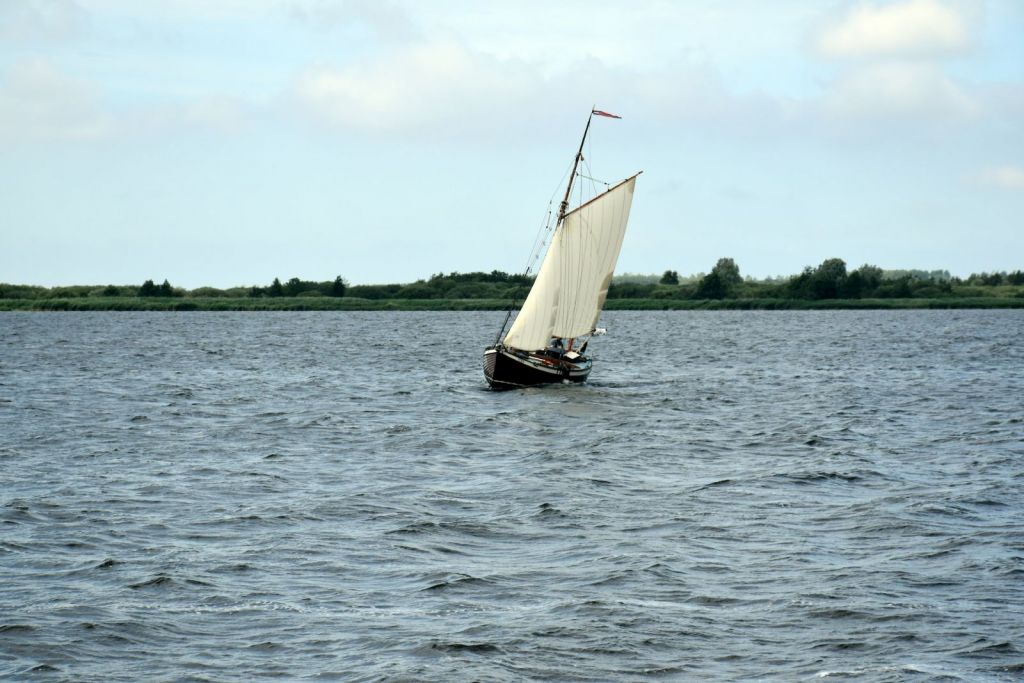
On this page:
The best solo bluewater sailboats, what makes a good solo bluewater sailboat, cost considerations when choosing a sailboat, maintaining your bluewater sailboat, contessa 32 is a classic, compact, and seaworthy sailboat.
Contessa 32's sturdy construction and excellent sailing performance have earned it a legendary reputation among sailors. With a well-designed interior layout, it has space for living aboard during your solo adventures. The Contessa 32 is a classic bluewater sailboat designed by David Sadler in the 1970s. It is known for its excellent balance, seaworthiness, and speed. It has a full keel, moderate displacement, and a classic design that has stood the test of time.
Westsail 32 is known for its rugged construction
The Westsail 32 gained fame as an affordable, rugged, and capable long-distance cruiser. Its full keel and sturdy hull ensure a comfortable ride in rough seas. The practical, function-driven interior makes it easy for solo sailors to maintain and navigate the vessel while providing essential amenities for an extended voyage.
Westsail 32 is another classic bluewater sailboat that was designed by William Crealock in the 1970s. It is known for its rugged construction, spacious interior, and excellent performance in heavy weather. The Westsail 32 has a full keel, heavy displacement, and a classic double-ender design.
Hallberg-Rassy 42F is known for its top-notch craftsmanship
The Hallberg-Rassy 42F is another superb choice for single-handed bluewater sailing. This Swedish-built yacht is well-renowned for its top-notch craftsmanship, stability, and comfort. It offers a spacious, well-lit interior, ensuring you'll enjoy your time below deck while cruising the open seas.
Hallberg-Rassy 42F is a modern bluewater sailboat designed by German Frers in the 1990s. It is known for its luxurious interior, excellent performance, and high-quality construction. The Hallberg-Rassy 42F has a fin keel, a spade rudder, and a modern design that combines comfort and performance.
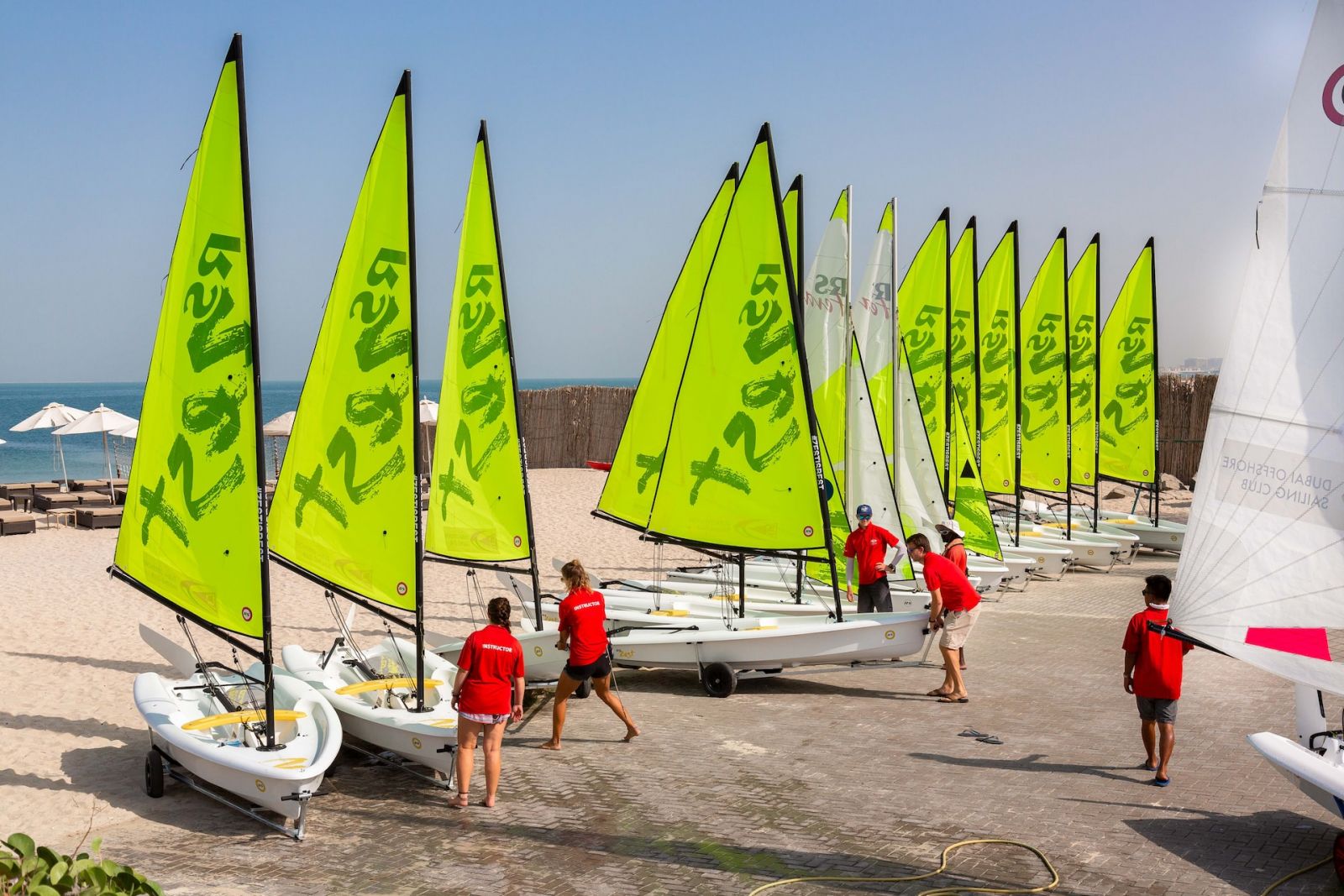
Pacific Seacraft 37 is designed for serious cruising
Pacific Seacraft 37 is a sturdy and reliable boat for solo sailors. Its moderate displacement and full keel provide excellent stability, while the well-thought-out interior layout includes abundant storage and comfortable living quarters. Its reputation as a proven bluewater cruiser makes it a top choice for solo sailors. The Pacific Seacraft 37 is another classic bluewater sailboat designed by Bill Crealock in the 1970s. It is known for its excellent balance, seaworthiness, and comfort.
Island Packet 38 is known for its spacious interior
Island Packet 38 is a popular choice among solo cruisers, thanks to its stable full keel design and living space. Its build quality, comfort, and performance make it well-suited for long-distance sailing. The spacious interior and practical layout ensure you have everything needed for a successful solo journey. Island Packet 38 is a modern bluewater sailboat designed by Bob Johnson in the 1990s. It 38 has a full keel, moderate displacement, and a modern design that combines comfort and performance.
Aside from bluewater sailing , there are other types of sailing discussed in this article.
Tayana 42 is known for its excellent balance, seaworthiness, and comfort
Tayana 42 is a comfortable, sea-kindly sailboat, ideal for single-handed offshore cruising. Its balanced performance, easy handling, and well-equipped interior ensure a safe and comfortable journey. It is well-regarded among sailors for its proven bluewater capabilities and timeless styling. The Tayana 42 is another classic bluewater sailboat designed by Bob Perry in the 1970s. It has a full keel, heavy displacement, and a classic design that has stood the test of time.
The Amel 54 is known for its luxury and exceptional build quality
This French-built vessel offers a spacious and comfortable interior with top-of-the-line amenities, making it an excellent option for solo sailors seeking a bluewater cruiser to explore the world in style and comfort. Its easy-to-handle design with advanced sailing systems allows you to sail solo with confidence and ease. The system includes electric winches, furling sails, and a self-tacking jib, which make it easy to handle the boat in all conditions.
To learn more about bluewater sailing , here's our comprehensive article on it.
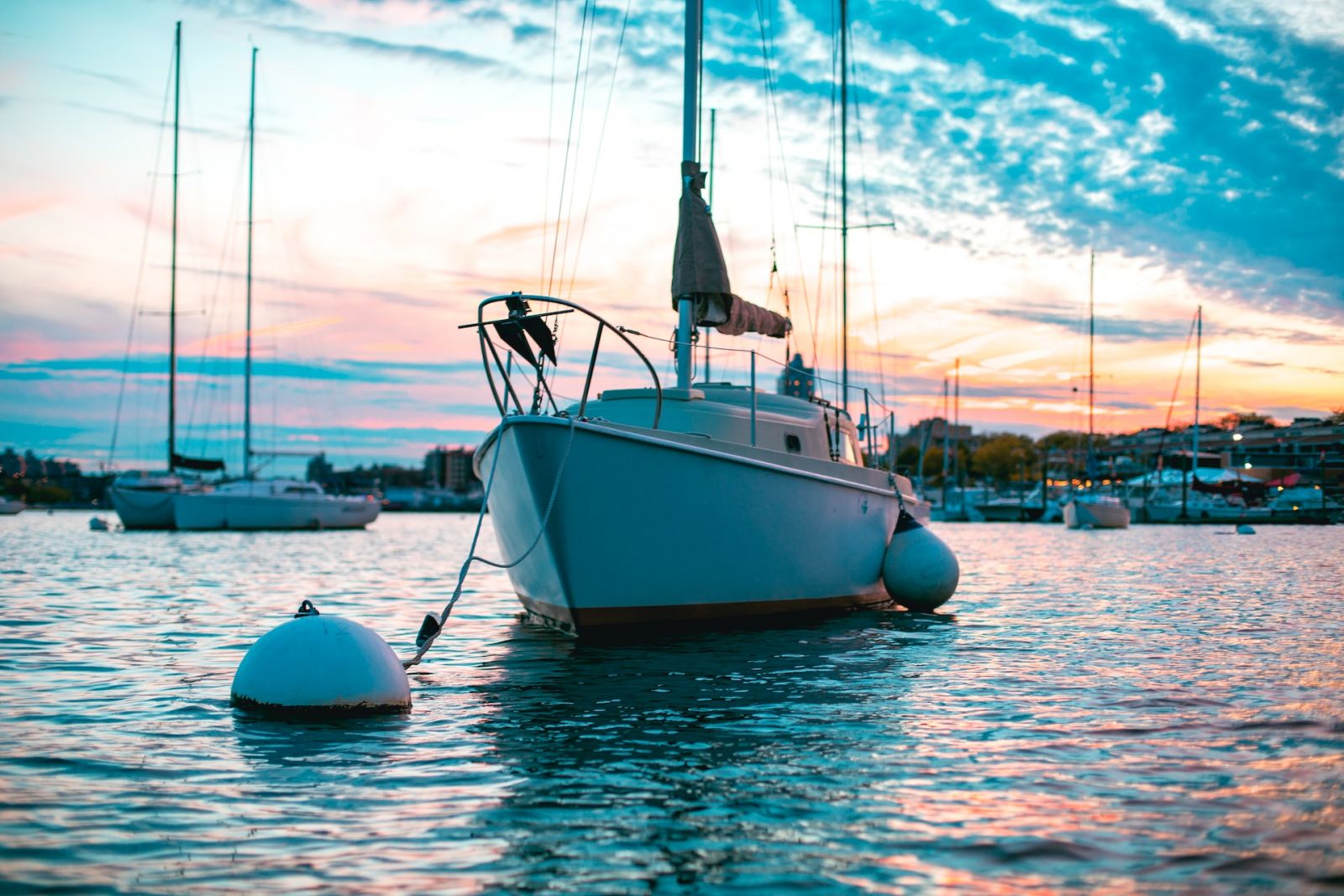
These factors will ensure not only your safety but also your comfort and ease during your sailing adventure.
Size and stability of a solo sailboat
A boat with a wide beam and short waterline provides more stability, making it easier for you to handle the vessel on your own. Some popular sailboat models known for their size and stability include the Westsail 32 and the Hunter Channel 31.
A good solo bluewater sailboat should be large enough to provide adequate storage space for supplies and equipment, while also being stable enough to handle rough seas and high winds. It should also have a well-designed hull shape that provides good stability and balance, and a keel that provides good tracking and prevents the boat from capsizing.
Ease of use and maneuverability of any solo sailboat
Features like roller furling and an electric windlass can make handling the sails and anchor much more straightforward. Also, hydraulic bow/stern thrusters with remotes can help you maneuver your boat easily and safely. Make sure to look for these features when choosing your bluewater sailboat.
A good solo bluewater sailboat should be easy to handle and operate by a single person. It should have a sail plan that is easy to adjust and control, and a steering system that is responsive and easy to use. It should also have a well-designed cockpit that provides good visibility and protection from the elements.
Durability and seaworthiness for long-term safety
A well-built sailboat with a history of proven offshore performance should be at the top of your list. Some of the best and most famous bluewater sailboats include the Alberg 30 and Hanse 371.
A good solo bluewater sailboat should be built to withstand the rigors of extended ocean voyages. It should have a strong, well-built hull that is capable of withstanding heavy seas and high winds. It should also have a well-designed rigging system that is strong and durable, and a keel that is designed to provide good stability and balance.
To learn more about the best keel design for bluewater sailing , here's our article on it.
Comfort and livability of a solo sailboat
Consider the layout and features of the boat, ensuring that it has a comfortable sleeping area, a well-equipped galley, and ample storage space. A good example is the Valiant 40, known for its excellent layout and seaworthiness.
A good solo bluewater sailboat should be comfortable and livable for extended periods of time. It should have a well-designed interior that provides adequate storage space, comfortable sleeping quarters, and a functional galley and head. It should also have good ventilation and lighting, and be well-insulated to provide protection from the elements.
Affordability and availability determine the sailboat's practicality
Set a budget and research suitable sailboats within that price range. Some budget-friendly options include the J/109 and Westsail 32. A good solo bluewater sailboat should be reasonably priced and readily available. It should be affordable for most sailors who are interested in long-distance cruising, and should be available for purchase or charter in most parts of the world.
If you're looking for bluewater sailboats under 40 feet , here's our article where we picked the top 13 most famous ones.
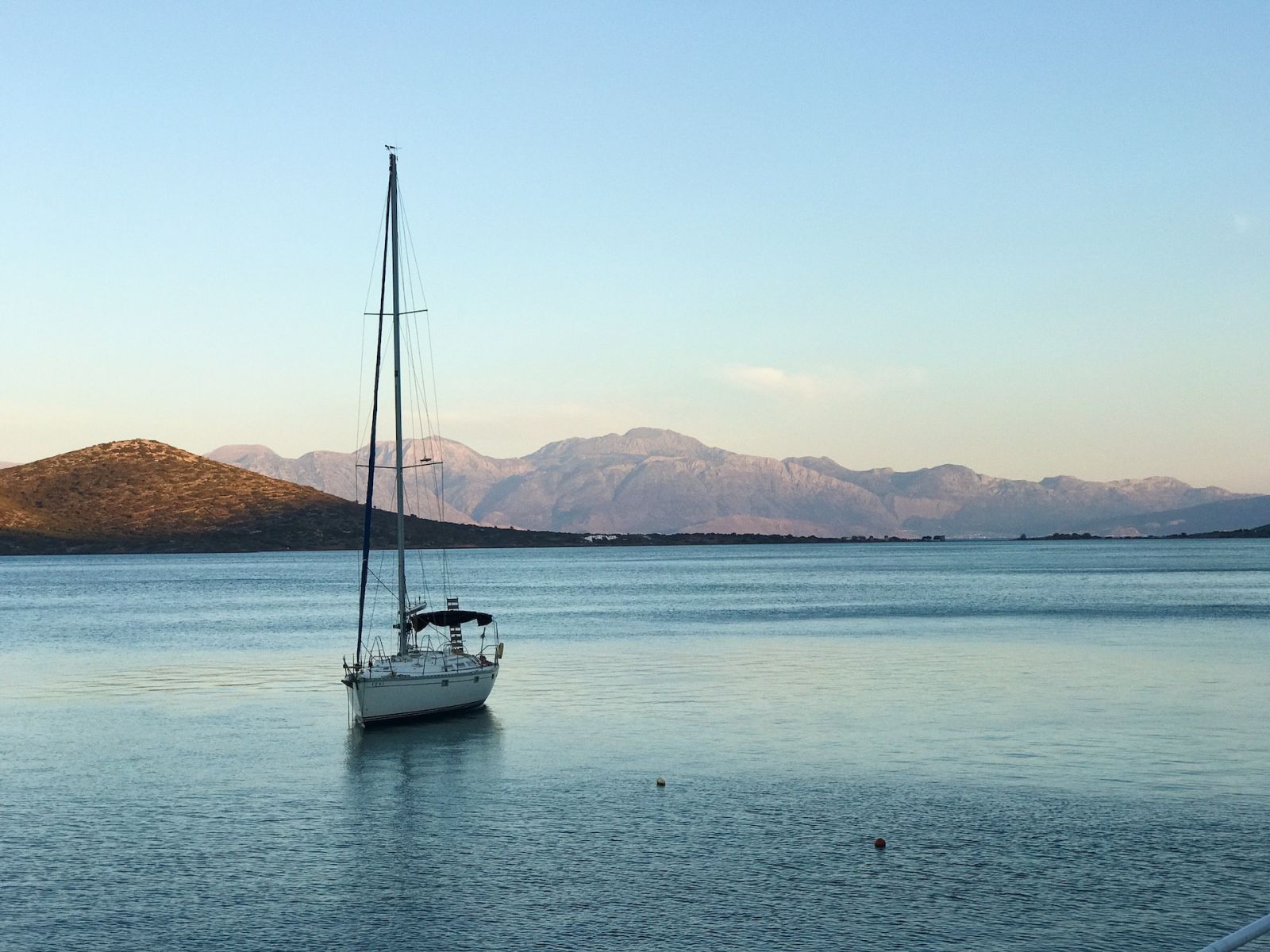
You'll be faced with a range of solo bluewater sailboat options, from budget-friendly to luxury models. Let's explore some factors you should keep in mind to make the best decision for your needs and budget.
Initial purchase price : This is often the first thing people think of when it comes to the cost of a sailboat. There's a wide range in prices, depending on factors like age, size, and brand. For example, a used Alberg 30 might cost between $10,000 and $15,000, while a new Amel 54 could be in the range of hundreds of thousands of dollars. It's important to find a balance between quality and affordability that suits your needs and financial capabilities.
Maintenance and repairs : Owning a sailboat comes with ongoing expenses to keep it in good sailing condition. Regular maintenance tasks like painting, replacing worn rigging, and inspecting safety equipment can add up over time. Be prepared to allocate a portion of your budget for these essential tasks, as neglecting them could lead to more expensive repairs down the line.
Marina fees and insurance : Depending on where you plan to keep your boat, you may incur costs for marina or dockage fees. Additionally, securing insurance coverage for your sailboat is a must to protect your investment. Both of these costs can vary widely, so make sure you factor them into your overall budget.
Upgrades and equipment : To ensure your sailboat is well-suited for solo bluewater sailing, you might need to invest in upgrades to improve its safety and performance. For instance, you may want to add a roller furling system, wind vane, or more advanced navigation equipment. These enhancements can amount to a significant investment, so it's wise to plan financially for any desired upgrades.
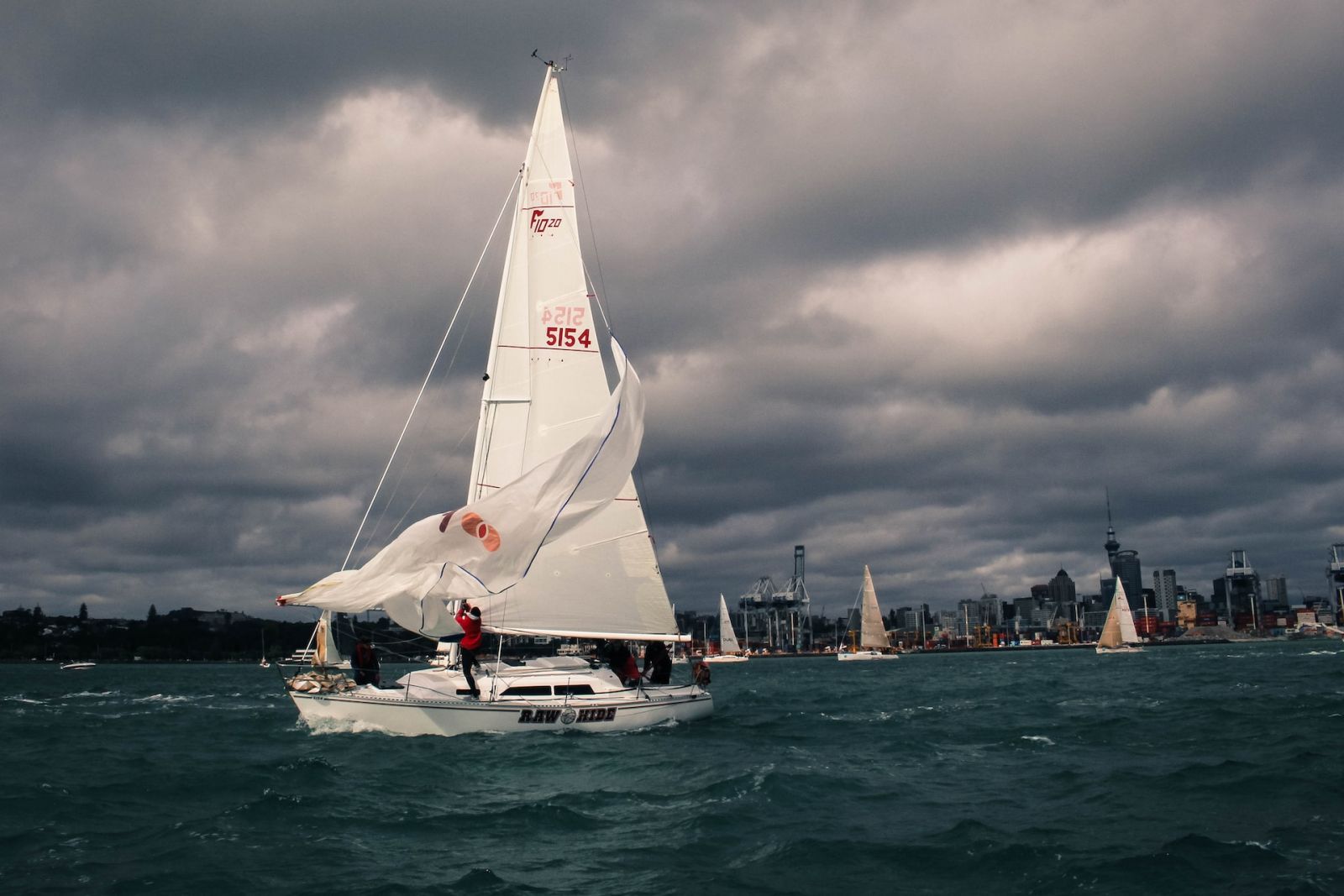
Here are some essential tips to keep your boat in top shape, and ensure its long life and performance during solo journeys:
Regular inspections : Make it a habit to perform a thorough inspection of your sailboat periodically. Examine the rigging, sails, hull, and all mechanical components. Routine inspections allow you to detect any signs of wear, damage or potential problems before they escalate.
Cleaning : Keep your sailboat clean by washing it regularly with freshwater and appropriate cleaning solutions. This simple practice prevents the buildup of dirt, salt, and other debris, which can cause corrosion and damage to your vessel over time.
Checking the bilge : Ensure that your bilge pump is working efficiently and that there's no water accumulating in the bilge area. If there are any signs of water accumulation, investigate the source and address any leaks or issues promptly.
Servicing the winches : Winches play a crucial role in your sailboat’s performance, so it’s essential to inspect, clean, and grease them regularly. This practice will guarantee their smooth operation and prolong their lifespan.
Sail care : Inspect your sails frequently for any tears, wear, or damage. Repair or replace them as necessary. To protect your sails from the sun’s harmful UV rays, always use a sail cover when not in use.
Keeping records : Maintain a logbook to document all maintenance tasks, inspections, and repairs. Not only will this help you keep track of what has been done, but it will also provide valuable information if you decide to sell your sailboat in the future.
Leave a comment
You may also like, what is bluewater sailing.
It's easy to confuse offshore sailing with bluewater sailing - and it's no wonder. Many people do, including myself. So I've decided to list the difference once and …
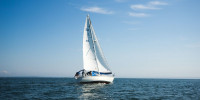
13 World-Famous Bluewater Sailboats Under 40 Feet

What's the Best Keel Design for Bluewater Sailing?

Different Types of Sailing and Racing Explained

41 Sailboat Cruising Essentials for Long Trips
Own your first boat within a year on any budget.
A sailboat doesn't have to be expensive if you know what you're doing. If you want to learn how to make your sailing dream reality within a year, leave your email and I'll send you free updates . I don't like spam - I will only send helpful content.
Ready to Own Your First Boat?
Just tell us the best email address to send your tips to:
Great choice! Your favorites are temporarily saved for this session. Sign in to save them permanently, access them on any device, and receive relevant alerts.
- Sailboat Guide

- Collections
Blue Water Boats
This collection of capable blue water boats features time-tested sailboats with rich histories.
Bluewaterboats.org built an encyclopedia of offshore sailboats for the sailing community. It contains a thorough summary of the history, details of the design and construction, and sailing characteristics on 99 sailboats.

Alajuela 33

Alajuela 38

Albin Vega 27

Allied Seawind MK II Ketch

Aquarius 24 Pilot Cutter

Bayfield 36/40

Bristol 41.1

Bristol Channel Cutter

Cabo Rico 38

Cape Dory 25

Cape Dory 28

Cape Dory 36

Cape George 36

Catalina 27

Cavalier 32

Cavalier 36

Columbia 29

Contessa 26

Contessa 32

Pacific Seacraft Dana 24

Downeaster 32

Endeavour 42

Endeavour 43

Falmouth Cutter 22

Fast Passage 39

Pipedream 37

Gemini 105M

Hallberg-Rassy 31

Hans Christian 33
Hans christian 38 mkii.

Hans Christian 38 Traditional

Hans Christian 41 Traditional

Hudson Force 50

Island Packet 31

Gin Fizz 37

Kelly-Peterson 44

Lord Nelson 35

Morris 28 Linda
Nor'sea 27.

Pacific Seacraft 25

Pacific Seacraft 31

Pacific Seacraft 34

Pacific Seacraft 40

Pacific Seacraft Crealock 37

Pacific Seacraft Orion 27

Passport 40

Pearson 36 Cutter

Pearson Rhodes 41

Pearson Triton
Tom thumb 24.

Southern Cross 31

Southern Cross 35
Southern cross 39.

Spencer 35 MK I

Tartan 37 (S&S)

Tayana Vancouver 42

Valiant Esprit 37

Vancouver 27

Pretorien 35

Westsail 28

Westsail 32

Westsail 42

Embed this page on your own website by copying and pasting this code.

- About Sailboat Guide
©2024 Sea Time Tech, LLC
This site is protected by reCAPTCHA and the Google Privacy Policy and Terms of Service apply.

11 Best Single Handed Bluewater Sailboats

Sharing is caring!
We know that you’re serious about sailing when you finally think of venturing to the ocean. Who can resist dreaming of solo sailing through the Atlantic? This is an adventure to prove your advanced skills, strength, and experience.
But before going off on your ocean adventure, you need to plan and prepare . We cannot stress enough the importance of good equipment. There is a lot of sailboat types and models in the market and we want to help you choose the best one for your needs.
Do you know what hull, rigging, and keel types you will need? What’s the best material and model for you to buy?
We will guide you through important sailboat features needed for the cruise. Follow this review until the end and we will share the 11 best single-handed blue water sailboats for your solo ocean sailing!
What Size Sailboat Is Best for Single-Handed Sailing
What type of hull handles rough water the best, sailboat keel types for blue water sailing, keel or decked stepped mast, sloop or ketch, how many spreaders, cutter rig, self steering gear, furling sails, westsail 32, albin vega 27, pacific seacraft 34, canadian sailcraft 36 traditional, hallberg rassy 352, contessa 32, fast passage 39.
If you are planning to manage your boat single-handedly, then size is an important factor to consider. It can affect the size of your accommodation, and maybe the boat’s design for speed and power.
Being alone, you need to have a clear overview of what is happening on your boat. This is especially important when maneuvering or for docking operations.
Experienced sailors can handle a 60-foot sailboat but novices would find it difficult with its steep learning curve . Check out the Vendee Globe if you don’t believe me. In general, a good sailboat size for single-handed sailing would range from 25 to 40 feet.
We recommend sailboats with sizes under 40 feet. These have good displacement and are great when against bad weather. They are solo-friendly and simply the most manageable.
But in the end, choosing a suitable size depends on your experience and preference. You need to consider your overall health, age, and physique. Make sure to have a complete understanding of your sailboat before going on your journey to prevent accidents.
The hull or the main body of your boat comes in varying shapes and sizes. Each different type of hull is designed for specific purposes.
When venturing the blue waters, you need to have a hull design that could handle rough waters easily. The hull shape determines the performance of your sailboat and therefore, should align with your strengths and skills.
Today, the most popular design would be the heavy displacement hull . This design is intended for ocean cruising and longer sailing travels.
It has great stability and performs better the deeper the draft is. With this design, you would expect a slow and steady motion during your sea travels with minimal effort.
V-type hulls, on the other hand, are designed to plane or ride on top of the water. You can usually see these types of hulls on powerboats. The V-type hull usually has a bigger engine and best when dealing with choppy waters while moving at high speed.
Narrow beams are also a great option for those who are looking for another ocean friendly feature . These are usually seen in traditional sailboats.
Canoe stern or the double are considered to be the best sterns for offshore sailing. They help cut through a following sea and really helps prevent the waves from pushing the stern over too much. It also has great buoyancy and balance that is perfect for bluewater cruising.
The best materials for hulls would be fiberglass, metal, and aluminum. These are durable and could last for decades if properly maintained.
Aluminum is lightweight and has resistance to corrosion and impervious to magnetism. Boats built with aluminum are fast, stable, and seaworthy.
Fiberglass hulls need less attention. Currently, boats are usually made of fiberglass as the material is easier for companies and also great for seakeeping and stability.
Metal like steel has high abrasion resistance. It helps retain the boat’s appearance but can be prone to rust and corrosion.

A keel is a fin-like blade found at the bottom of a sailboat. It supports the ballast and helps to control and steer the boat.
It is generally designed to stop the boat from getting blown sideways because of wind pressure. The full keel, modified full keel, fin skeg, and fin spade rudder are all suited for bluewater sailing.
A full keel runs along the full length of the boat – from the bow to the stern – which makes it the most stable in the water. It carries the vessel well and is the safest to use when grounding as it reduces the chances of damage.
This is most ideal when cruising and the most comfortable out of the four keel types with its minimal heel. Although the slowest on the list, it has great directional stability and steering capability.
An improved version is the modified full keel . It is a hybrid with improved windward performance and better heel reduction than the full keel. However, it made small concessions on its stability and comfort.
Meanwhile, the fin keel with skeg rudder has more strength and protection against damage and impact. It also has better mobility and steering capability.
This type has a faster speed and windward performance compared to the modified and full keel types. It is also more balanced, which is ideal for cruiser-racer types of sailboats.
Lastly, we have the fin with a spade rudder. This is the fastest type on the list but also the most vulnerable as the spade rudder greatly relies on the rudder stock. But if you want speed and great windward performance, then this type is the right one for you.
Sailboat Rigging Types
Rigging is the whole system of ropes, chains, and cables. It supports the sailboat mast and controls the sails’ orientation and degree of reefing.
There are two main groups of sailboat rigs, Deck Stepped and Keel Stepped. The main difference lies in the location of its mast step. Both are fine choices and the better rig would depend on your preference.
Just as its names suggests, you can find the mast stand on top of the deck with Deck Stepped and on the hull’s bottom with Keel stepped. This means that to reach the keel, the mast would need to pierce through the cabin.
Deck Stepped rigs have masts that are more flexible because of their contact points, and are easily adjustable for optimal performance. Keel Stepped rig is rigid and strong and offers slow and steady cruising.
Now let’s move on and talk about Slope rigged and Ketch rigged. Which is better?
A sloop rig is simple. It is composed of a mast with a jib and a mainsail. Ketch, on the other hand, is more complex with its two masts with any foresail, main and mizzen mast combinations.
If you are choosing between Sloop and Ketch rigged sailboats for solo sailing, then we recommend Sloop. Although, Ketch is manageable and can be easily used with less strength and effort. This is perfect for cruising as it can work around multiple sailing conditions.

In terms of spreaders, you can freely choose between a single or dual spreader. This deflects shrouds and supports the mast. We do recommend dual spreaders but single spreaders are also good.
It’s just that double spreaders give the rig more strength and better sail control.
The cutter rig is sometime referred to as an inner forestay or baby stay. Simplest way of describing it is that you have two head sails instead of just one. Gives you more options on sail configurations.
Single Person Sailboat Equipment and Gear
Your sailboat would not be complete without gear and equipment. You might want to invest in autopilot or wind vane, furling headsails, electric windlass, life jackets, and AIS to make your voyage much easier.
Wind Vane is an autopilot steering that you can use without electricity. It is usually placed on the back to catch the wind and respond to various wind conditions.
It automatically adjusts the rudders in response to the wind to alter the boat’s course. This is helpful because it’s like having another crew member on board you don’t have to listen to and feed.
Headsail furling or roller reefing is necessary for easier management of your headsails. It is important to have a functioning and updated roller furling system in order to reef, dowse, or stow the headsail efficiently.
Another item we would recommend is an electric windlass . You can choose one that works vertically or horizontally, depending on your needs. This will help you move the anchor effortlessly with a single button. Using the two windlasses that god gave you makes anchoring more difficult then it needs to be.
Life jackets are a must in every sailboat. Just be sure it fits you and that you know how to use it. Also, be sure to buy a coast guard approved product with a harness that could support your weight.
The Automatic Identification System (AIS) will help you avoid collisions . It is recommended to get a receiving and transmitting one when going solo sailing.
This way, you and the other boats with AIS within the radar area are alerted to each other’s speed, course, and direction.
Really, you won’t know what you might encounter in the ocean so you must always be prepared. We hope that these items will help you achieve a safer and more secure sailing experience.
11 Best Sailboats for Solo Sailing
Now, here are 11 sailboats that are best for solo sailing. Any of these vessels are guaranteed to take you safely and comfortably anywhere around the world.

This is a long full keel fiberglass sailboat that was built from 1971 to 1981. Its design was based on a previous model, Kendall 32, and has an amazing interior size geared for comfortable cruising.
W32 is widely noted for its seaworthiness. It is built with a strong and durable design and materials to resist extreme sea conditions.
It was used on various voyages and circumnavigations. Its hull is a heavy displacement and double-ender type designed for long periods of sailing.
It is also a cutter-rigged sailboat equipped with a single mast, forestaysail, mainsail, and jib. Its overall length including the bowsprit and boomkin is roughly 40 feet, which is perfect for sailing single-handedly.
Most people would note that the speed and acceleration of W32 are quite slow. This is due to its larger wetted area and sometimes newbies’ mistake of carrying too much on board.
With the right keel, sails, and rig configurations you can improve on W32’s speed and weaknesses. As seen from David King’s documented modifications, W32 proved to be safe, steady, and fast when sailing on blue waters.

Vega 27 is a modified full keel sailboat with a masthead sloop rig. It was designed around 1966 and became the most popular production sailboat in Scandinavia.
It has a unique look because of its reverse sheer commonly seen in smaller boats to increase the area of its interior. It is made with fiberglass, but has a narrower hull compared to similar sized boats in its class.
Its shallow hull has a large cutaway as seen with modified full keel designs. This can make her quite stiff, heeling to about 15 degrees when its shoulders are buried.
Still, it is great for single-handed sailing because of its manageability and balance under different conditions. You cannot help but admire its light helm and great tracking capability.
Vega’s light air performance is okay but it shines when the wind blows at 15 knots or more. It could even maintain its dryness even with rough waves and weather conditions.
The most comforting feature would be its control and stability at all times unlike other more modern vessels with spade rudders. Overall, it is safe and ideal for longer cruises offshore.

This 30-foot traditional sailboat could take you anywhere. Alberg is notable for its narrow beams, long overhangs, and full cutaway keel with its directly attached rudder.
It is strong and durable. Its materials were mostly aluminum, hand-laid fiberglass, and polyester resin. More ballasts were produced in later productions as the early ballast was built with iron as opposed to the original lead design.
Alberg is greatly influenced by folk boats in Scandinavia. It is built with fiberglass and has an interior with comfortable full standing headroom and a well-vented galley.
This classic design from 1962 is ideal to cross oceans and is used for various circumnavigations. Alberg is a stable and seaworthy boat that could even be used in casual racing. Its best point of sail seems to be a beam reach and close reach.
It is praiseworthy when crossing oceans. Unlike modern designs that tend to be thrown around on rough seas, Alberg’s narrow beam design slices through big and rough waves and moves quickly. Under extreme weather conditions, it could perform heaving-to and lying-a-hull with no problems.
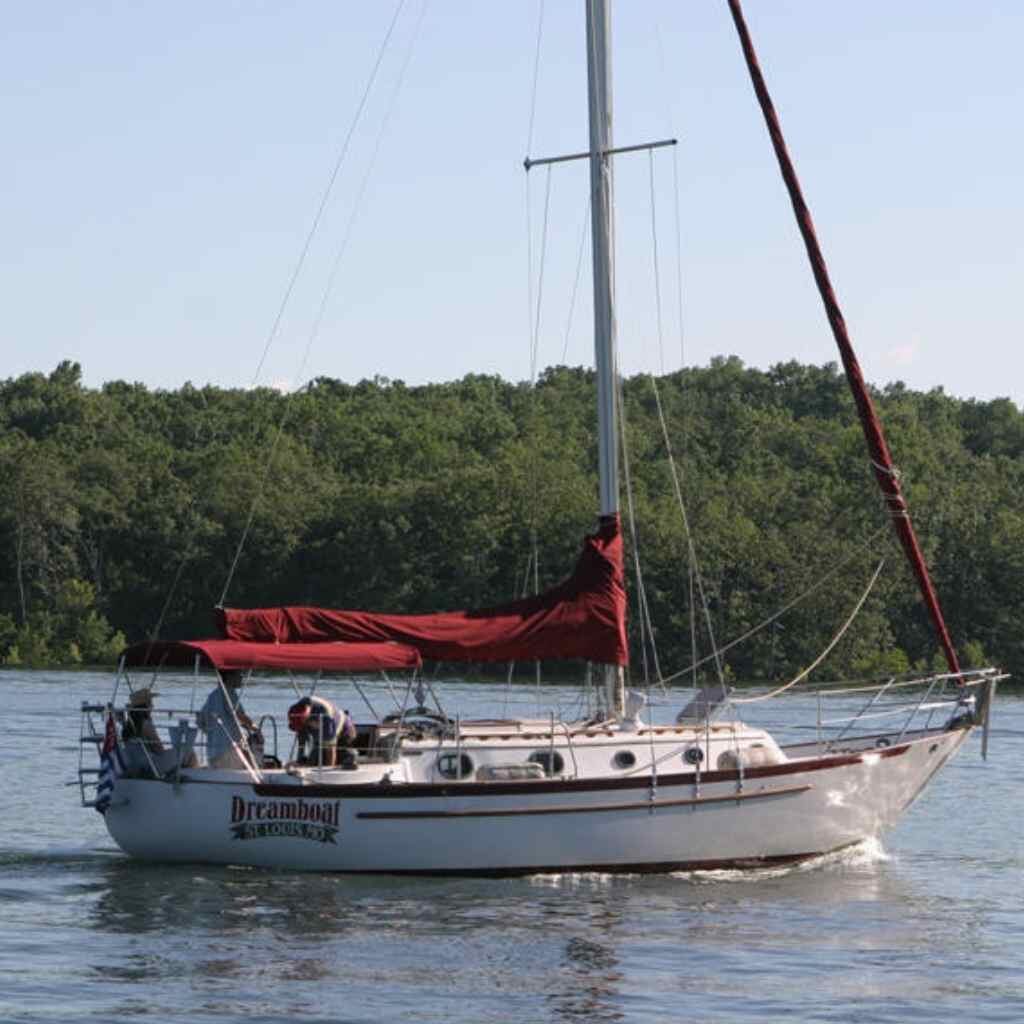
Pacific Seacraft 34 is a smaller heavy displacement semi-long keel sailboat based on the highly successful Crealock 37. It has the same graceful lines and appearance as the Crealock and is known as the Voyagemaker.
It is built with comfort and safety in mind with its large overhanging bow and beautiful sheer line ending with a traditional canoe stern. Constructed with the highest standard, it is a seaworthy sailboat that is ideal for bluewater voyages.
It is a cutter-rigged sailboat with skeg-hung rudders and control lines being fed back to its cockpit. The smaller cockpit may feel cramped but its design lowers the risk of flooding.
Still, it has a great interior suited for living aboard. It has a large headroom, comfortable galley, and up to five berths for comfortable cruising.
Although you may feel some hobby-horsing windward because of the overhangs, Seacraft 34 is overall a very balanced boat with great upwind performance. It has outstanding control capabilities and is able to sustain surfing speed with ease.

This is a double-ended full keel cruiser designed by Bob Perry and built-in Taiwan in response to the rising popularity of Westsail 32. It was offered to the market as a semi-custom boat and built with high-quality materials.
You can modify the internal layout and can choose a ketch, cutter, or pilothouse version. There is an option to use wood or aluminum spars. The mast could also be keel-stepped or deck-stepped.
Before, only 20 were ketch sailboats due to the popularity of the cutter design at that time. Now, ketch has proven to be faster and more balanced between the two.
Tayana is relatively faster than any sailboat in its class. Its best point of sail is in its broad reach. It also tracks well windward, and is an ideal choice for the trades. It is also great how the cockpit is secured from any flooding even when traveling.
Today, a lot of people are still actively sailing this. Tayana 37 has become well known for offshore and blue water sailing.

Canadian Seacraft is well known for its fiberglass racer and cruiser. CS 36 is a small traditional fin keel sailboat with a masthead sloop intended for recreational use. It is seaworthy and has good performance in different weather conditions.
It was designed by Raymond Wall and had a production run between 1978 to 1987. It remains to be popular in both north and south borders.
It is a beautiful sailboat with a graceful sheer line and balanced overhangs at both bow and stern. Its details and quality in design and production are clearly of a higher tier.
It is mostly built with fiberglass and balsa wood. It is equipped with an internally mounted spade transom hung rudder. All of its lines lead to the cockpit, which is ideal for single-handed sailing.
CS 36 Traditional also has a deep-depth draft and wide beams with great access to the cockpit and foredecks. It is wide and spacious, which is perfect for comfortable cruising.
The sailboat has great proportion and traditional aesthetics. It is simple and straightforward, which makes it ideal for bluewater sailing.

This is a sturdy and high-quality sailboat built between 1978 to 1991. It features a progressive design, combining a walk through with the aft-cabin from the main saloon. It is made with a tall and standard rig each supported on double and single spreaders, respectively.
Hallberg Rassy 352 has a nicely balanced hull sporting a fin keel with rudder on skeg, a generous beam, and a 45 percent high ballast ratio. Its water and fuel tanks are placed low in the keel to improve sail carrying ability.
Its production spanning 14 years allowed for continuous improvements in its specifications. Newer sailboats have raised hulls for bigger headroom in the under the deck, aft cabins, and the walkthrough. Engines were also replaced by a Volvo and later a Penta Turbo or the bigger MD 22.
It is impressive how they balanced good interior and sailing performance. It has great seakeeping ability and smooth motion in heavy seas, easily an ideal sailboat for singlehanded sailing.

Corbin 39 was designed based on a Dufour design named Harmonie, increasing freeboard, and flushing the deck. Its style is influenced by the classic Scandinavian cruiser, Westsail 32.
It has a long fin keel, blunt bow, and a high freeboard. It was sold as kits, and various deck molds were produced. They have pilot, aft, and center cockpit variations.
It was made of sturdy and high-quality materials. The earlier version’s decks were of marine grade mahogany but it was later changed with Airex foam. Its lead ballast was encapsulated with fiberglass for added protection.
Earlier boats had a single spreader main or a turbocharged double spreader. Later, Corbin used 49 feet double spreader rigs instead, and all were deck-stepped.
Corbin 39 is truly a strong and seaworthy vessel. With its fin keel and skeg rudder, cutter rig, and reefed main combinations, it could take anyone safely and comfortably anywhere in the world.

Valiant 40 took its looks from Scandinavian double-ender sailboats. It had a successful production run that spanned for 47 years. It proved to be one of the pioneers for modern blue water designs.
Its hull is made from thick hand-laid fiberglass, bolted and covered with teak. Its ballast is cast with lead bolted to the keel stub. Lastly, the skeg is constructed separately from hull molding and encased with fiberglass before being fastened to the hull.
It has a beautiful bow and sheer lines and a longer LWL for maximum speed. At the back are a non-spacious cockpit and a canoe stern ideal for bluewater sailing operations.
Under the waterline is a fin keel with its skeg hung rudder. It perfectly matches with the cruising hall above, minimizing wetted surface area
Overall, Valiant 40 is a seaworthy vessel with great blue water performance. Extremely balanced and well-mannered, it can withstand extreme weather conditions with ease and minimal effort on your part.
It soon gained a reputation as a fast water passage-maker with high integrity. Now, it is regularly used for circumnavigations by solo sailors and voyagers.

If you like a sailboat with a proven track record, then Contessa 32 is for you. It is a seaworthy racer-cruiser with good all-around sailing capabilities released in 1971.
Like its younger sister, Contessa 26, it has great speed, integrity, and affordability . Contessa 32 is a definite combination of old and new with its traditional narrow beam, a full hull with a fin keel, and fiberglass rudder protected by a skeg found in more modern yachts.
It has marked overhangs and a narrow tuck-up stern. It has less headroom below in return for its lesser wind resistance.
This configuration delivers fast racing speed and great stability. It could definitely withstand extreme weather and rough waves. Contessa 32 is claimed to be able to right itself when rolled or capsized.
Contessa 32 is known for its forgiving nature. It has a responsive helm and excellent windward performance. With its astounding stability, it can carry full sail for up to 25 knots.

Fast Passage 39 was designed by William Garden and is said to be a legendary cruiser with speed, ruggedness, and fame. It is a stout double-ender comparable to the Valiant 40.
It has the same LOA and LWL as Valiant and also has nearly identical ballast and displacement. The difference is its narrower frame and more evolved underwater shapes resulting in flatter forward and aft keel sections and less wetted area. It also has great directional stability as its rudder allows great control under wind vane and down steep waves.
It is a high performing sailboat but also difficult to find as only 41 were produced. A part of the group was offered as hull and deck kits intended to be finished by the sailboat owners.
Fast Passage 39 also has a proven track record and has won single-handed blue water races. It performs great under a wide range of conditions, especially in light winds.
By now you should have some idea what makes a vessel Bluewater friendly. There are hundreds of vessels that can make long distance voyage safe and enjoyable. These examples above are just a few examples of the Best Single Handed BlueWater Sailboats.
Leave a Comment Cancel Reply
Your email address will not be published. Required fields are marked *
Save my name, email, and website in this browser for the next time I comment.
Get your "Sailing and Boating" Free Guide
Yachting World
- Digital Edition

4 best bluewater cruisers of 2022
- Toby Hodges
- March 28, 2022
Thinking of heading off on a world-girdling cruise or just want to cross oceans in style? Here's the best bluewater cruisers of 2022 that will help you se off on a new life at sea

The results are in from the European Yacht of the Year Awards as the judges have announced their top four bluewater cruisers of 2022.
The European Yacht of the Year awards are well regarded as the definitive yacht awards in the world a variety of categories are judged by the panel from best luxury cruisers , to best family cruisers to performance yachts .
But for those looking to liveaboard their yacht, making plans to do some ocean crossings, or looking to undertake some long distance passage making, the best bluewater cruisers will likely be the category that draws the eye.
There were a brilliantly diverse and interesting collection of new designs for this category – a celebration of French ingenuity. For those planning long term cruising, would you choose a robust aluminium build for higher latitudes sailing, shoal draught to tuck into the shallows (a mix of both?), sustainable living or reliable comfort, or the ability to log sustained high speeds to outrun weather systems? This selection gives you all those choices and more.
Best bluewater cruisers of 2022
The new flagship Allures 51.9, for example, is a no-nonsense adventure cruising design built and finished to a high standard. It retains Allures’ niche of using aluminium hulls with glassfibre decks and superstructures, which, the yard maintains, gives the optimum combination of least maintenance and less weight higher up. Priorities for this design were a full beam aft cabin and a spacious, long cockpit. Both are excellent, with the latter, at 6m long, offering formidable social, sailing and aft deck zones.
It likes some breeze to come to life on the wheel, but I appreciate that it’s designed to take up to five tonnes payload. And I like the ease with which you can change gears using the furling headsails and the positioning of the powerful Andersen winches inboard. The arch is standard and comes with a textile sprayhood or hard bimini.
Below decks you’ll find abundant headroom and natural light, a deep U-shape galley and cavernous stowage. For those who like the layout of the Amel 50 but would prefer aluminium or shoal draught, look no further.
Allures 51.9 price: €766,000
The Ovni 370 is another cunning new aluminum centreboard offering, a true deck saloon cruiser for two. The designers say the biggest challenge was to create a Category A ocean going yacht at this size with a lifting keel, hence the hull had to be very stable.
Enjoyable to helm, it has a practical, deep cockpit behind a large sprayhood, which can link to the bimini on the arch. Many of its most appealing features lie in the bright, light, contemporary, clever, voluminous interior, which has good stowage and tankage allocation. There’s also a practical navstation, a large workroom and a vast separate shower. I particularly like the convertible saloom, which can double as a large secure daybed or pilot berth.
Potentially the least expensive Category A lift keel boat available, the Ovni will get you dreaming of remote places again.
Ovni 370 price: €282,080

There’s no shortage of spirit in the Windelo 50. We gave this a sustainability award after it’s founders spent two years researching environmentally-friendly composite materials, developing an eco-composite of basalt fibre and recycled PET foam so it could build boats that halve the environmental impact of standard glassfibre yachts.
The Windelo 50 is an intriguing package – from the styling, modular interior and novel layout to the solar field on the roof and the standard electric propulsion, it is completely fresh.
Windelo 50 price: €795,000
Best bluewater cruiser of 2022 – Outremer 55
I would argue that this is the most successful new production yacht on the market. Well over 50 have already sold (an equipped model typically costs €1.6m) – and I can understand why. After all, were money no object, I had this design earmarked as the new yacht I would most likely choose for a world trip.
Indeed 55 number one Sanya, was fully equipped for a family’s world cruise, and left during our stay for the Grand Large Odyssey tour. Whereas we sailed Magic Kili, which was tricked up with performance options, including foam-cored deckheads and supports, carbon crossbeam and bulkheads, and synthetic rigging.
At rest, these are enticing space ships. Taking one out to sea is another matter though. These are speed machines with the size, scale and loads to be rightly weary of. Last month Nikki Henderson wrote a feature for us about how to manage a new breed of performance cruising cats just like this and how she coaches new owners. I could not think of wiser money spent for those who do not have ample multihull sailing experience.
Under sail, the most fun was obviously reserved for the reaching leg under asymmetric, where we clocked between 11-16 knots in 15-16 knots wind. But it was the stability and of those sustained low teen speeds which really hit home – passagemaking where you really cover miles.
Key features include the swing helms, which give you views from outboard, over the coachroof or from a protected position in the cockpit through the coachroof windows, and the vast island in the galley, which is key to an open plan main living area. It helps provide cavernous stowage and acts as the heart of the entertaining space as it would in a modern home. As Danish judge Morten Brandt-Rasmussen comments: “Apart from being the TGV of ocean passages the boat offers the most spacious, open and best integration of the cockpit and salon areas in the market.”
Outremer has done a top job in packing in the creature comforts, stowage space and payload capacity, while keeping it light enough to eat miles. Although a lot to absorb and handle, the 55 offers a formidable blend of speed and luxury cruising.
Outremer 55 price: €1.35m

Best luxury yacht: 7 ultimate luxury cruisers you can buy
The definition of the best luxury yacht will differ according to personal opinion and from boat to boat. This year’s…

Best yacht 2023: European yacht of the year winners
The European Yacht of the Year programme is a highlight of my year as it gives us jury members the…

Best family yacht: our pick of the best yachts for sailing with the family
There are many categories in the European Yacht of the Year awards, from the best luxury yachts to performance yachts. But some of…

Best performance yachts: Our pick of the top options
The European Yacht of the Year awards is the most thorough and impartial awards programme – the winners here are…
If you enjoyed this….
Yachting World is the world’s leading magazine for bluewater cruisers and offshore sailors. Every month we have inspirational adventures and practical features to help you realise your sailing dreams. Build your knowledge with a subscription delivered to your door. See our latest offers and save at least 30% off the cover price.

Sail Far Live Free
Top 10 favorite affordable bluewater sailboats.
- Blue Water on a Budget: 5 Budget Cruisers for Crossing Oceans
- Go Small and Go Now: 5 Pocket Cruisers to Take you Anywhere
- A Proper StinkPot: Top 5 Pilothouse Motorsailers
- The Voyager's Handbook: The Essential Guide to Blue Water Cruising by Beth Leonard
- How to Sail Around the World: Advice and Ideas for Voyaging Under Sail by Hal Roth
- Twenty Small Boats to Take You Anywhere by John Vigor
Great post... Most of these boats are slow for their waterlines and, for me at least, speed is a factor in safe passagemaking due to the ability to avoid and dodge weather. I want the ability to easily make 7+ knots in all conditions. (I don't take this as a compromise to seakeeping.) One quirk of the HC33: The teak decks were fastened from the bottom up (e.g. through the deck) and the heads were then glassed over. (Not joking.) The tips of the screws pricking your feet is the first clue your decks need replacing. From my dock neighbors entire summer (3 full days per week) this is a truly massive problem to fix and delayed their cruising dream by a year.
timone - Great comments, thanks! I agree, there's a definate choice to make between speed and tank-like toughness. My personal preference for bluewater is a a heavy full keeler, though this may change with experience. Maybe I'm too wrapped up in the asthetics of these classic designs. Good tip on the HC33. I'm leary of teak decks on any boat due to maintenance issues and would prefer any of the above boats without teak decks.
You are on to something with these large dispacement boats. power or sail . they are the best
Semi-bunk. We sailed a Cal 40 all over the SoPac; not the ideal cruiser but certainly seaworthy. Most of our class of 2008 were fin keel, and some form of spade rudder. With the exception of the Valiant and the Tayana, most of these clunkers are better suited to the dock.
Our family sailed the East Coast and Caribbean for two years and I loved our Lord Nelson's teak decks. The teak is first to dry after the morning dew. A small leak disappeared as it swelled in the warm humid tropical weather.
To me to "dodge weather" when you are in the mid of an ocean has little meaning, unless you have a really fast boast like those racers who do the Volvo ocean race. If you are short handed a slow boat will give you a better chance to rest during a storm, which is paramount for safety, while the fast one will wear you out.
A massive...and very expensive problem to fix.
Even ocean racers get caught at sea in bad weather and more the a few have capsized and demasted. No sail boat can outrun the weather. Even motor yachts with huge Diesel engines that can motor at 20-30knots get caught at seas in bad weather. And many times sailing away from shore and weathering the storm at sea is safer then trying to enter a harbor once the blow is there. Many inlets are risky when the current and winds create breaking waves that can swamp a small craft or force it on to the rocky shore attempting to enter. There are times going further away from shore is safer then attempting entry into the harbor. Having a boat that will ride out a storm safely is worth losing a few knots on passage.
Great list! Not sure the HC33 meets your $50k criteria though. I have yet to see it under $75k in decent condition.
Hahn - True enough, finding a HC33t for $50k is a difficult proposition. But the boat is s so beautiful and so well made that I had to include it, even if finding a good one may mean spending $25k more.
Yes the Baba 30 would fit the Boat Porn listing ! I'll tell my wife that's what I'm doing as I sit with blurry vision @ 2am ! Looking at Porn !!
Agreed, the Baba 30 is really beauty. The canoe stern is perfectly in proportion with the rest of the boat and makes for a really sweet profile.
Our good friend has a HC33 and we have a W32. Its amazing how close they are in sailing ability. I think the W32 tracks a tad better and the HC33 is just a hint more nimble, but they are very close in our limited experience. We really love the HC33's pullman berth in the center of the boat but at the same time we don't enjoy the forward head nor do we like the table layout on the HC33 which requires a lot of people to get up if the person furthest in the booth needs to get out. Its a toss up between the HC33 and W32 about interior layout overall. We love the little quarter berth "room" in the HC33 but at the same time you sacrifice a lot of space in the engine room. The W32 gives you a lot better access to the motor. If push came to shove, I'd take the HC33's extra berth instead of the berth in the center of the W32 factory layout. The cockpits are very close in size (read:small). The HC33 has a rounded cabin top that makes sitting on the edges of it more of a pain, but the W32 requires drop boards or water will run into the cockpit. The W32 does win in price competition though. No comparison there. Just wanted to add some thoughts to your post.
Great comments, thanks for sharing Tate. It's always good to hear from someone who has hands-on, side-by-side comparison experience. I agree the forward head on the HC33 isn't ideal, but I do like that it has a stall shower. If price isn't an issue, maybe the real way to decide between the W32 and the HC33 is the size of the crew. The W32 might be the choice for 2, while the HC33 might be better for 3-4 based on having two private sleeping quarters.
Downeaster 32' is a clear contender here, and also wins as most beautiful ;-D and very stable. Also possibly the largest interior per length? Great head room.
Agreed, the Downeaster is a real looker and a lot of boat for 32 feet, particularly given their value pricing on the used market.
I owned a Downeast32. Roomy yes,slow?, yes! Very slow. Had 7 people on her for an overnighter. Storage everywhere. Lots of rear deck space.
I wouldn't say the Downeaster 32 is merely a contender, but possibly an outright winner in the category of "Affordable Bluewater Sailboats",.. ,much more so in fact than 10 boats mentioned in this article,.. at least from the prices I've seen. I honestly don't understand why something like HC33 even gets a mention,.. beautiful? definitely!!!,.. but affordable??!!,, hmm,. not so much.
Fair enough. I included the HC33 because it's one of my all time favorites and the definition of "affordable" is subjective. As I've defined it here, ~$50k. Yes, that's a stretch for the HC33, but I've seen a few approaching that price point. As for the DE32, she's a capable beauty too.
No mention of the Nor'Sea 27.... Should be on the list for sure. :)
I didn't include the Nor'Sea 27 here, but it is in my list of favorite pocket cruisers to take you anywhere .
Hello, I appropriate your reviews. Our family own CSY-33. Now a day, sailing is a completely new sport for me and I wasn't sure what to expect but I've definitely got the bug. thanks all, @Nadia Brightman :)
Glad to hear you're enjoying your CSY 33!
My wife is 5'9" and I 6'3". Which of these wonderful boats would have sufficient headroom and a nice sleeping double for a couple like us?
This is a great post. I just restored a little Hunter 25 and plan to sell it to get something bigger. It's nice to dream! I second the comment about the Downeaster. I love double enders and clipper bows. How about a Bayfield!
Thanks Dan. I like Bayfields (and other Ted Gozzard designs) too, but they're outside my top 10. Thanks for reading.
Bluewater Offshore Cruising Sailboat Bluewater Cruiser New French-built cruiser with a distinctly American look. Here’s an interesting design from Group Finot for Beneteau. I find interesting the fact that this design is not especially “Euro” in its styling. In fact, it’s sort of American looking and good looking too. So, let’s examine this profile in detail. The transom is traditionally raked as opposed to reversed. This eliminates the standard swim step we see so often. But Beneteau has countered this with a drop-down platform that extends about a foot beyond the transom. This platform is raised and lowered by block and tackle. A sliding flush-deck hatch covers the steps when they are not in use. This is an elaborate and very well thought out transom detail that will allow you to bring your dinghy up next to the boat without threatening the gelcoat on the transom edge. This traditionally raked transom really drives the look of this boat. It certainly affects the character of the sheer. I would have liked to see a bolder sweep to this sheer, but it’s fine as is. Note how the tip of the transom is at the waterline. This, combined with the short bow overhang, produces a long sailing length. I think the designers have done a good job of blending the deck structures with the hull. The D/L of this design is 183. L/B is 3.38, making this a moderately beamy boat on the lighter side of medium displacement if we choose 200 to be the middle of current D/Ls for cruising boats. The keel is a bulbed fin giving 5 feet, 11 inches of draft. Note the deep forefoot on this design and the straight line to the canoe body profile. All in all this is a handsome and moderate hull. The interior shows a two-head, two-stateroom layout with the galley in the passageway to the aft cabin. The galley is spread out fore and aft, but it looks to me like there is still plenty of working room. The aft cabin has a large double berth and symmetrically arranged lockers and settees. Why settees? Well, they look good and occupy volume that is not much good for anything else due to the shape of the hull. There is a head with shower stall adjoining the aft cabin. The saloon has a dinette, which to my eye looks on the minimal side. I suppose you could seat four for dinner if you had to, but it would be a tight squeeze. The forward stateroom has a double berth with the toe end cut away to make room for the forward head. I’m not sure how this berth would work for a couple. Obviously, the biggest advantage to center-cockpit boats is the separation of the sleeping accommodations. There is space below the cockpit for the engine room. Putting the cockpit in the middle of the boat allows the designer to place the mainsheet traveler at the end of the boom and place the traveler where it will not interfere with the cockpit layout. This rig is well forward and shows swept spreaders with forward lower shrouds. Unfortunately, the sailplan we have is not carefully drafted so it doesn’t do much for the look of the boat. The photos also show a staysail. This is a very nice looking boat. The windshield is fixed and, while obtrusive in the drawing, looks just fine in the photos. I’m not too keen on the wheel position. It is a bulkhead-mounted wheel offset to starboard, much like we see on cruising catamarans. This means you will sit in one position at the wheel without the benefit of being able to turn 90 degrees or change sides. This wheel arrangement does free up the rest of the cockpit and puts the helmsman securely under the dodger. A teak-capped bulwark adds a rich look to the deck. Beneteau’s boats always deserve a close look. The company obviously puts a lot of market research into its new models. In this case the company has given us a well-designed boat with some unusual features. This is one boat I’ll definitely board Beneteau Wave Rider 42CC at Annapolis.
I wonder if the keel will stay attached
I've saled from the Med to Australia on my own Beneteau Oceanis 42cc and plan to continue the circumnavigation via cape Town to the Caribbean in April 2015. We love our Bene layout... Fun to sail . The center cockpit is Ideal. The aft deck spacious and the aft cabin just wonderful. A huge engine room accommodates all our gear.water maker. Genset. Tools....
Hey, I think a strong case could be made for Bayfield 32 cutters, beautiful boats and pretty bullet proof as well. speed is a bit of an issue! great post!
I single-handed a Bruce Roberts 31 (schooner-rigged) across the Atlantic and back . I was 70 yrs.old, the boat did the work. Also, list the Dreadnought 32 (Tahiti ketch in heavy fg).
I'm intrigued by many of the Roberts designs and metal boats in general, but I don't have any experience with either. The Dreadnought is another really cool and unique double-ender with a lot of character...often available for a bargain price. Thanks for sharing.
Yeah how about some feedback on the Alberg's. They seem worthy & affordable too. Please respond, thx. L
My first true-love in sailboats was the Pearson Triton 28, of course designed by Carl Alberg. As my experience and taste evolved, I began to prefer canoe sterns and slightly more modern designs. The biggest fault I can find with Alberg designs is that many seem to have very narrow beams, making them tight for family cruising. The narrow beams can also contribute to a tender boat. However, Alberg did a fine job of making his designs very sexy with swoopy sheerlines and long overhangs. The Triton, 35 and 37 are all capable and proven offshore boats.
The HC33 shown, Sabbatical. is for sale @ $95,000. Ouch.
Agreed, that's a steep price. I've seen 2 33t's that needed a little TLC sell near $50k. In general, the HC 33t probably has the highest average price of any in my list, but its' such a sweet ride!
You forgot the Allied Seawind 32 for $25,000
Good call! The Seawind II (32') is but one of several Gillmer designs worthy of any "best affordable bluewater cruisers" list. Others include the Southern Cross 28/31/35, Weatherly 32, Aries 32 and Roughwater 32. Perhaps it's time I write a sequel to this post to include the many good recommendations from the comments. Note - I did include the Southern Cross 28 in my post called "Bluewater on a Budget: 5 Budget Cruisers for Crossing Oceans."
there is one you may have over looked! tanzer 10.5 pilot house! not the fastest but with it's swing keel it is a fun wide nice sailing boat!! and great for the island's
I like the Tanzer 10.5, but is she bluewater capable? Definitely a unique look, in a good way. And Tanzer has a good reputation for affordable quality and decent sailing performance.
This is almost the identical boat to a Southerly 10.5 which has made many ocean crossings. Definitely bluewater capable. I own hull # 11 built in 1983 and she has sailed completely around the world spending a lot of time in the South Pacific. She has a righting angle of 140 degrees with the lifting keel up. The hull to deck joint is glassed over on the inside during production resulting in a absolutely solid boat with no joint leaks. The amount of storage is phenomenal for those long passages. I have had her out in 50 knots with no issues. The self tending jib makes single handing easy, and with the keel down to 6.5 feet she handles well.
Could an old Irwin 37 MK I be upgraded so she can be blue water capable? If so...HOW?
I suppose anything COULD be upgraded to bluewater capable, but at what cost? The I37 is known for it's roominess and affordability, but not necessarily offshore capability or robust construction. Irwin's can be fine boats (I owned one for 5 years), but they would not be my choice for bluewater. If you're simply considering passage from Florida to the Bahamas, or some island hopping in the Caribbean, then there are plenty of Irwin's with that under their belt, but an ocean crossing or a run to Bermuda in an I37 should be carefully considered. For more info and specifics about the I37, try Jack Horner's review here: http://www.boatus.com/boatreviews/sail/Irwin37.asp
What about the Irwin 42 Ketch? Is it what you would consider blue water worthy?
What, no mention of the Bill Garden designed Fast Passage 39?
Love the Fast Passage 39 and Garden's original s/v Bolero! Thanks for the addition.
Aah there I am trying hard to decide which one to choose........except I couldn't afford even a model version! So I content myself by saying that at nearly 60 and with no experience wòrth talking about I'm way to old to start now. Youtube and some of the wonderful sailing videos help a bit!
Tashiba 31 is heavy duty double ender good for ocean crossings don't you think? I like the cutaway forefoot.
One of Bob Perry's personal favorite designs, or at least he thinks highly of it. It's also one of his last full keel designs. “I think the Tashiba 31 and 36 mark the best boats I ever designed with modified full keels. The boats were fast, close-winded, stiff, and well balanced. I constantly got calls from owners telling me how they had “beat” a local contemporary design.” (from Yacht Design According to Perry).
Why no mention of the Cabo Rico 34?
James - The Cabo Rico 34 is certainly worthy of this list. In fact, so is the Tiburon 36, the first boat built by Cabo Rico and perhaps a bit more affordable than the 34. The Tiburon is a Crealock design and eventually became the CR 38. Thanks for the addition!
Another good boat is the Gulf 32. Solid build, good tankage, though at this age the 75 gal fuel tank needs serious inspection. William Garden feels it is one of his finest, safest designs!
A boat that is not so well known in European and N.American circles is the Oswald Berckemeyer designed Miura 32.Built strong to cope with South African waters it has been said (though I am not sure how true) that more circumnavigations have been carried out in Miura's than any other class of boat.I owned a Corrida which is the 36foot version of the boat (also designed by Berckemeyer) and I took this boat across the Atlantic without a worry. Strong and fast - I loved that boat.
Hi Mike. I am trying to find drawings, specs and photos of the Corrida 36. Very little available online. Can you point me to anything you are aware of? Thanks.
Did any one mention a DownEast 32? They may be fat and slow, but so is the WestSail 32. Any one agree / dissagree?
Hey I did a post at Urban Nomads about your excellent blog. Check it out here: http://urban-nomads.net/great-boat-living-websites. Thanks for the helpful tips!
The Southern Cross 31 / 35 / 39 really should be on this list. Excellent heavy displacement boats that will take you anywhere.
Agreed. I'm a fan of Southern Cross sailboats and Gilmer designs.
What is your position on an Island Packet 320?
I've never sailed a 320, but I do like IP's in general for their salty style, solid construction and seaworthiness. I particularly like the 320's rig - a cutter is nice for having headsail options and the Hoyt staysail boom keeps things simple. IP's tend to command an upper tier price and aren't known for speed, but if you can get beyond those two factors, the 320 looks to be a nice size and layout for a cruiser.
I love your list. Mine would be very similar, but might include the Endeavour 37. It's hard to beat the price!
I sailed our HC 33 from Alaska to New Zealand on a 5-year cruise. We loved how she handled in heavy weather. We are in the 50+knot "club" and our HC did great while other cruisers suffered dearly. While she isn't fast, she tracked well, and behaved at anchor or hove to. Yes, the teak deck is something to consider, but overall, not a deal breaker in the big picture of off-shore cruising. We sold our HC in New Zealand because I had to return to work. I miss her every day. I am plotting to get another bluewater boat. At this point my short list is another HC or perhaps an Island Packet or Pacific Seacraft. If I were rich, it would be a Najad. These choices are based on our years sailing with other cruisers. While boats are so incredibly expensive, the bottom line is safety at sea, getting parts in exotic locations, and the cost of repairs. The better you are equipped before leaving home port, the less likely you are to have life-threatening problems or serious repairs in expensive locations.
You missed Acapulco 40, so likely never read "One Wave at a Time" by Ed Atkin - regards, Matt
Thanks for the kind word for the Fugi 35. Here's one you can have for under $50k. Needs a little work but is a great boat. miami.craigslist.org/mdc/boa/d/classicblue-water-passage/6479457885.html
I don't see Corbin 39
Thank you for the article it has given me information on my up coming purchase I'm working towards living aboard my own sailboat as I travel the East Coast, Caribbean, South America and West Coast in my retirement years.
I understand this is US based but as a Brit I used to covet the Tradewind 35, a proper long keel, flush decked, cutter rig, blue water cruiser. If money was no object that is the boat for me.
Post a Comment
Popular posts from this blog, go small and go now 5 pocket cruisers to take you anywhere.

Escape to the Sea: How to get from the Great Lakes to the Caribbean

Weather Forecast
2:00 pm, 06/12: -11°C - Partly Cloudy
2:00 am, 07/12: -4°C - Clear
2:00 pm, 07/12: -7°C - Partly Cloudy
2:00 am, 08/12: -3°C - Overcast
- Cruising Compass
- Multihulls Today
- Advertising & Rates
- Author Guidelines

British Builder Southerly Yachts Saved by New Owners

Introducing the New Twin-Keel, Deck Saloon Sirius 40DS


New 2024 Bavaria C50 Tour with Yacht Broker Ian Van Tuyl

Annapolis Sailboat Show 2023: 19 New Multihulls Previewed

2023 Newport International Boat Show Starts Today

Notes From the Annapolis Sailboat Show 2022

Energy Afloat: Lithium, Solar and Wind Are the Perfect Combination

Anatomy of a Tragedy at Sea

What if a Sailboat Hits a Whale?!?

Update on the Bitter End Yacht Club, Virgin Gorda, BVI

Charter in Puerto Rico. Enjoy Amazing Food, Music and Culture

With Charter Season Ahead, What’s Up in the BVI?

AIS Mystery: Ships Displaced and Strangely Circling

Holiday Sales. Garmin Marine Stuff up to 20% Off

- Boat Reviews
Go Small, Go Far, Go Now
BWS ‘s annual guide to great monohulls for coastal cruising, weekending and daysailing (published June/July 2016)
BWS has always been published for sailors who sail over the ocean’s horizon as they head to new landfalls whether that is down the coast or to some foreign land. But, BWS is also for sailors who may have already been there and done that or who are still ramping up their skills and their cruising kitties and are coastal cruising in the meantime.
So, with our fondness for good quality and innovative small cruisers in mind, we offer our annual guide to boats under 35 feet in three separate categories.
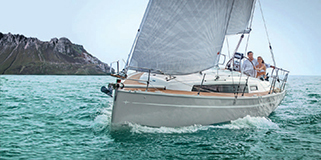
BENETEAU Group Beneteau, based in France, but with boat building facilities in the U.S., Brazil and southern Europe is the world’s largest producer of recreational boats. The Beneteau brand grew out of the sailboat market and that market is still vital to the company’s profile and image. They have always built entry level cruisers, racers and daysailers. Today, the Beneteau Oceanis 31 and 35 (new last year), are offshore capable cruisers that can be easily managed by a couple or cruised by a family. The 35, like the 38 that was launched a couple of years ago, is a modular boat with a variety of interior plans from daysailer to full on liveaboard cruiser. Both boats evoke the Euro-modern styling that Beneteau has adopted in its latest range of Oceanis cruisers. The First 30 is a racer cruiser with the emphasis on racing. While it will make a fine weekender it is really best suited to longer point to point races of several days or more. A truly fun boat to sail, the First 30 is a Porsche among the fleet of family cars. www.beneteauamerica.com
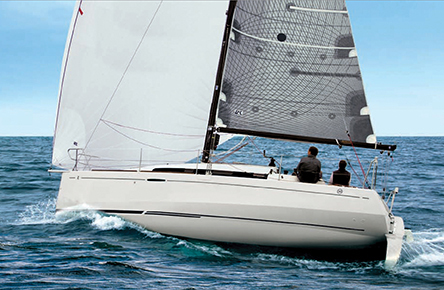
CATALINA Once America’s largest sailboat builder, Catalina has retrenched after the recession and is back building wholesome, good quality cruisers for families and couples. The little 315 is not so little when you climb aboard and has a sensibly proportioned cockpit that will seat six and an interior that a family of four will enjoy for summer cruises. The boat sails as well as any in this size range and is simple and easy to handle. The 355 is a significantly larger boat than the 315 and feels like a 40 footer of old. The fit and finish in the new Catalinas is among the very best in the production boat market, with solid wood doors and cabinet front, many useful drawers and the best stainless steel fittings. www.catalinayachts.com
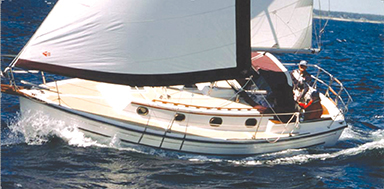
COM-PAC This family owned company in Florida has been quietly and steadily building small, high quality cruising boats and daysailers for two generations. The Com-Pac 27 is their coastal cruiser and has all of the accommodation and sailing qualities you need to truly explore the coast far and wide. Built to a high standard and fitted out with top of the line hardware and equipment, the 27 is a little yacht. For a couple or a young family, the 27 will be either a great last cruiser or a perfect entry level boat at the start of a sailing career. The boat looks traditional and definitely evokes the best in American yacht style over the decades. www.com-pacyachts.com
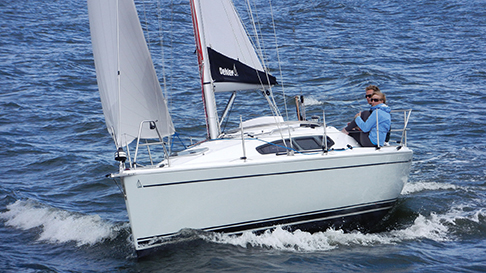
DEHLER Although not yet a well known brand in the US, Dehler yachts are very popular in Europe and the Dehler 29 is a highly respected racer cruiser with large one-design fleets. A true dual purpose boat, the 29 not only is a lot of fun to sail it is also a fast family cruiser with two private cabins, a roomy saloon, a full head and a useful galley. Between regattas, the 29 is a fine little cruiser. Dehler builds modern boats that uphold the older European traditions of fine woodwork, varnished interiors and well thought-out storage lockers. www.dehler.com
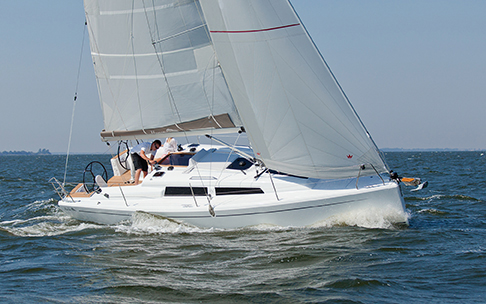
HANSE The German invasion of North America—Bavaria, Dehler and Hanse—now accounts for a healthy percentage of new sailboat sales. Hanse has seen steady growth in America in no small part because it builds and delivers roomy, modern cruisers at a very fair price. In the under 35 foot category of smaller cruisers, Hanse offers the roomy 345 and the brand new 315. The 345 is a well-appointed and designed family cruiser with a simple rig—self tacking jib—a large cockpit and room below for two couples or a family of four. The new 315 is just as well appointed and fitted out and delivers a huge amount of cruising comfort in a small and affordable package. The 315 was named European Sailboat of the Year last winter by a panel of expert sailing journalists. www.hanseyachts.com
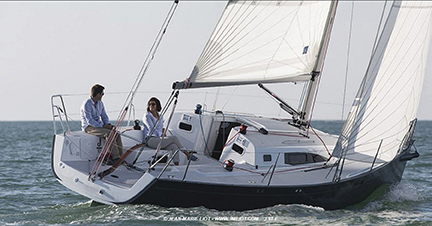
J/BOATS Last year, the letter E started appearing at the end of the usual numerical designations that J/Boats gives some of it boats. The E stands for Elegance and Evolution in performance cruising design. The 97E is a good example of where the E is taking the company. The new 31-footer has all of the sailing qualities you expect from J Boats and has won its class in major regattas in the US and Europe. So it is no couch potato. But it does have couches as well as standing headroom, two full cabins, an enclosed head, a seagoing galley and a large table with folding leaves. The interior is bright and open to the point that you feel like you are in a much larger boat. J Boats has been catering to dyed in the wool racers for years—900 J/70s have been delivered!—but with the E series they are offering up a line of boats that will appeal to dyed in the wool cruisers, too. Can you image teak decks on a J Boat under 50 feet? Well, now you can have them. www.jboats.com
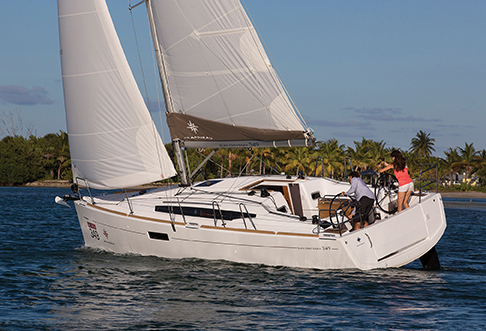
JEANNEAU Jeanneau—a part of the Beneteau Group—is now one of the largest sailboat builders delivering boats in North America and giving their sister company, Beneteau, a run for the money. They have the big boat part of the market well covered but they are not neglecting the entry level, either. The 349 that was introduced two years ago is a cracking little cruiser that sails circles around some larger boats and has the living and cruising accommodations of a 38 footer. The 33i is a smaller version but offers a lot of cruising capability in a very attractive and affordable package. These two Jeanneaus make great all around entry level boats. And they are built to a very high standard of quality. www.jeanneau.com
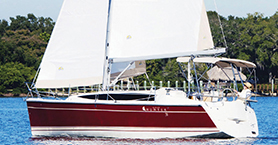
MARLOW HUNTER After failing during the recession and being acquired by David Marlow who builds luxury motor yachts, Hunter Yachts—now known as Marlow Hunter—has been steadily reinventing itself and its line of cruising boats. The all new MH 31 is a fully fitted out coastal cruiser that has a unique hull design—similar to the 37 and 40—and a simple rig that is easy for a lone sailor or couple to handle. With a lot of beam aft, the 31 has a good-sized cockpit with a stainless steel arch over it to carry the mainsheet. Down below there is a large cabin aft, a guest cabin forward and an enclosed head aft. The team at MH have steadily upgraded the finish work on the boats so the new 31 has a more yacht-like feel than Hunters of old. www.marlow-hunter.com
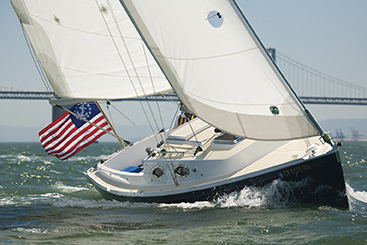
SCHOCK Two years ago Matt Rutherford sailed a Schock Harbor 29 from California to Japan as he documented the pollution collecting in what is known as the North Pacific gyre. So, he proved along the way that the new 29 is an ocean-quality mini-cruiser. The boat has everything you need to move aboard and sail away. As part of the Harbor series, Shcock also builds the Harbor 25 which is a solid little pocket rocket for weekending and summer cruises. The boats are built in California and have developed wide followings around the country. All of the boats are built with Hoyt Jib-booms that make the headsails self tacking. www.wdschock.com
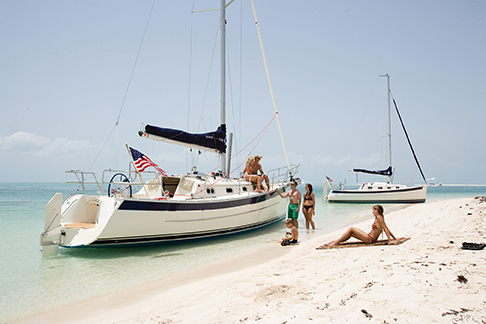
SEAWARD The Seaward brand, built by Hake Yachts, is owned and managed by Ted Gelov who is a successful businessman from the Midwest. His company recently completed taking over Island Packet Yachts and Blue Jacket Yachts in Florida where the Seaward line is being built. The Seaward 26R and 32 R are lifting keel designs that have proven very popular among those who sail the shallow waters of the Bahamas, Florida, the Chesapeake and elsewhere. The 26 has a roomy cockpit for four adults and can accommodate four people in the V-berth and settees below. The 26 is really a great couple’s boat. The 32 is more of a long range cruiser and can easily take you across the Gulf Stream to the Bahamas and be your floating home for a winter of island cruising. The craftsmen at Island Packet are doing a fine job building high quality Seawards that compare in quality to any boat in the under 35-foot range. www.seawardyachts.com
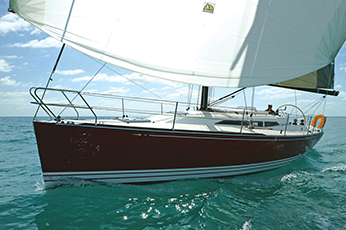
TARTAN Long one of America’s premier boat builders, Tartan was hit hard by the recession and has downsized and regouped under new ownership. Today Tartan is the only production builder in the country to build all epoxy yachts with all carbon fiber spars. The boats are very high quality—heirloom quality—and thus cost a bit more than competition coming from Europe or elsewhere. In the under 35 foot range, Tartan offers the 101, 115 and 3400. The 101 and 115 are pure racer cruisers that have proven to be successful around the race course and capable coastal cruisers. The 3400 is a fine example of Tartan’s best work reduced to 34 feet. The boat sails sweetly, it has a large cockpit and the interior has the warm comfort you expect from a Tartan yacht. www.tartanyachts.com
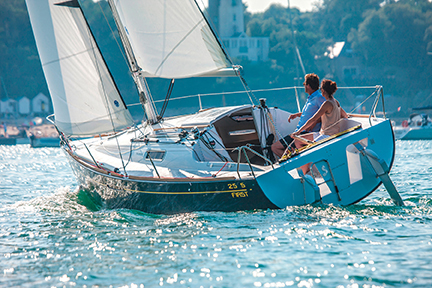
BENETEAU The Beneteau First 25 is a sweet sailing weekender that will be a lot of fun to race in PHRF events or club regattas. With a tall rig and plenty of sail area, the little speedster will scoot when the breeze is fresh. The boat can be rigged with a Code Zero and an asymmetrical spinnaker. The cockpit is set up for competitive sailing and a crew of up to four. Powered by an outboard, the motor hangs on a stern bracket where it can be tilted up and out of the water. Down below there is a small galley with a portable burner and a sink. The two bench settees can double as single berths and there is a V-berth forward of the enclosed head. A young couple or a group of friends could have a whale of a time sailing, cruising and racing the First 25. www.beneteauamerica.com
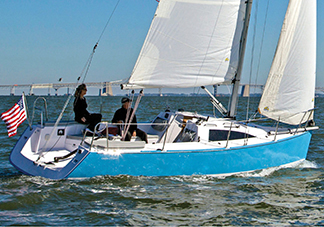
CATALINA The relatively new Catalina 275 is a real design departure for head designer Gerry Douglas. The 275 is a sport boat that doubles as a fun family weekender. It has a large sailing rig with a self-tacking jib and a bow sprit can be added to make flying the downwind sails more fun. It has an almost plumb bow and a wide open transom. The beam has been kept within the limits of trailering the boat behind a family car. The accommodation layout is basic but comfortable and four adults can sit in the saloon and enjoy a meal after a day of sailing. The enclosed head will be appreciated by all. The new look of the 275 is going to spark new larger sport cruiser boats from Catalina but this handy 27-footer may be all the boat you need. www.catalinayachts.com
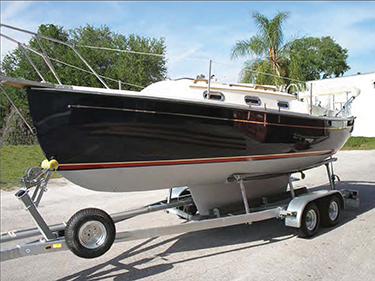
COM-PAC The Com-Pac 23 has been around for a while and should be included in any list of enduring small cruiser designs. Hundreds have been bought and sailed all over America. Trailerable, seaworthy and attractive, the 23 is a true little yacht. When Com-Pac came out with the 23 Pilothouse, they offered some of their older patrons a design that would allow them to sail under cover and enjoy a great waterfront view whether under sail or swinging at anchor. The cockpit is still big enough for sitting out in the sun. But when the rain comes, you can slip into the pilothouse and continue on your way. These are great little boats. www.com-pacyachts.com
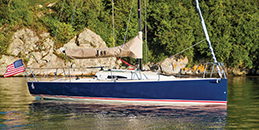
J/BOATS The J/88 and 95 are two special little cruisers that are designed to sail fast and win around the buoys while also offering their owners something more, enough space below to stay aboard for the weekend. The 88 is really a daysailer and regatta racer that at 29 feet will provide a lot of fun and silver. If you are inclined to stay aboard, of course you can but you will be camping. The 95 is a step up in accommodations and offer the unique quality of being a shoal draft cruiser. The boat is fitted with a shoal draft fin keel with a bulb that has a deep centerboard inside it. When sailing hard, you have all the performance of a deep keel, yet when slipping into a shallow anchorage, you can go where few other boats of this size could go. The twin rudders offer great steering and add to the shoal draft performance. Both the 88 and the 95 are sweet boats that sail particularly well. www.jboats.com
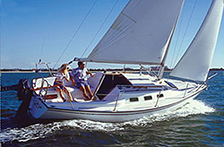
PRECISION For the last 38 years, Precision Yachts has been quietly building great little daysailers and pocket cruisers in Florida. The Precision 23 is a trailerable family cruiser that harkens back to the days when you didn’t have to spend a fortune to have a perfectly good cruising trailer-sailer. The cockpit will be comfortable for four adults and the accommodations are designed to have two sleeping forward in the V berth and two on the bench settees in the main cabin. Since it only displaces 2,500 pounds and a trailer will weigh around 1,000 pounds you will be able to haul your little cruiser to the best sailing grounds in America. The basic boat is under $40,000. With a trailer, outboard and upgraded sails, you will still be under $50,000. www.precisionboatworks.com
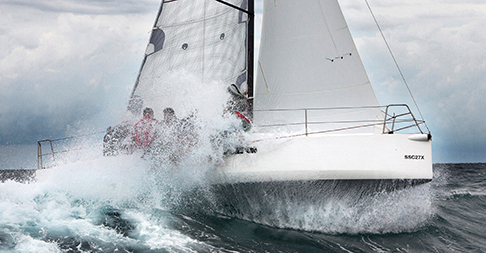
SEASCAPE Conceived by Slovenian mini-transat sailors and designed and built in Slovenia, the Seascape 27 brings all of the exciting performance of the Open class boats –Mini 6.5s, Class 40s and IMOCA 60s—to the recreational sailing public. The 27 is a boat that can break away and start planing in a good breeze and will regularly sail at double digit speeds off the wind. It has a folding keel, a tall fractional rig, a bowsprit and twin high performance rudders. The boat can be singlehanded or you can really make her fly with a crew of three. Oh, and there are pretty nice accommodations below for taking your partner and mates on a fun cruising weekend. Speed leads and the Seascape is definitely a leader. www.thinkseascape.com
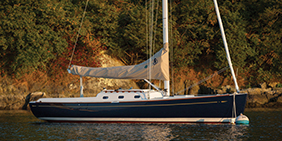
SPARKMAN & STEPHENS The Sparkman & Stevens 30, conceived by Bluenose Yacht’s principal Glenn Walters, is a classic looking weekender or daysailer. The design is based upon a 30-foot yacht named Babe that was designed by the legendary Olin Stephens in 1935 and used as a coastal racer and weekend cruiser. In those days, coastal racing included events like the 150-mile Florida to Nassau Race. The new 30 has a powerful rig and a thoroughly modern underbody; it sails amazingly well. The accommodations are sufficient for a couple weekending or perhaps a family with young children for a few days. This year, Walters has launched the all new S&S Open 30 which has a much bigger cockpit and a small cuddy cabin. The Open 30 is a daysailer that does everything well. The boats are very pretty and evoke the whole history of yachting in the American style. www.bluenoseyachts.com
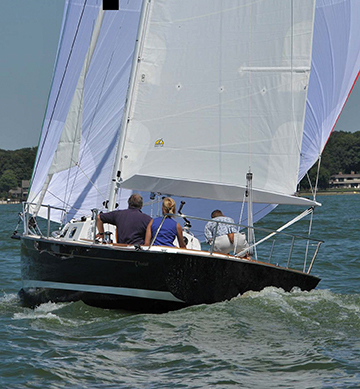
BENETEAU The First 22 came on the scene three years ago in a big announcement between Beneteau America and the American Sailing Association (ASA). The two companies were partnering in the design and marketing of a one-design that would become the new training boat for ASA sailing schools. The 22 was based on the First 20 and the original designers, Finot-Conq, stretched the hull and created a new simpler rig that would be good for beginners and more experienced sailors alike. The First 22 is gaining in popularity and the boat offers a great value for those looking for a well built, safe daysailer. www.beneteauamerica.com
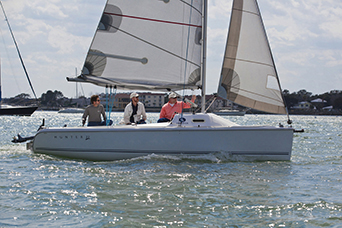
MARLOW HUNTER The Marlow Hunter 22 has been around for years but remains one of those basic daysailers that is hard to beat for functionality, sailing qualities and price. The boat is rated for five adults so you can take the whole family out for an afternoon. It is set up like a simple dinghy and is easy to handle. With a mini outboard on the stern you will always be able to get home when the wind dies. And with a little cuddy cabin, you have a place that offers a little privacy and a V-berth for naps. www.marlow-hunter.com
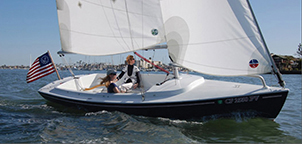
SCHOCK The Harbor 20 is one of those boats that has been building a cult following for years. Without a lot of fanfare and promotion, the little 20 footer, with its ample rig and self-tacking Hoyt jib boom, has seen one design fleets sprouting up all over the place. Why? Because the boat is good for older sailors who want to sit in a deeper cockpit, want to be able to race as a couple or two buddies, and want the performance of a sweet modern hull and a fin keel. It’s hard to find the best of both worlds—but Schock has achieved this in the Harbor 20. www.wdschock.com
Author: Blue Water Sailing
Leave a reply cancel reply.
- New Sailboats
- Sailboats 21-30ft
- Sailboats 31-35ft
- Sailboats 36-40ft
- Sailboats Over 40ft
- Sailboats Under 21feet
- used_sailboats
- Apps and Computer Programs
- Communications
- Fishfinders
- Handheld Electronics
- Plotters MFDS Rradar
- Wind, Speed & Depth Instruments
- Anchoring Mooring
- Running Rigging
- Sails Canvas
- Standing Rigging
- Diesel Engines
- Off Grid Energy
- Cleaning Waxing
- DIY Projects
- Repair, Tools & Materials
- Spare Parts
- Tools & Gadgets
- Cabin Comfort
- Ventilation
- Footwear Apparel
- Foul Weather Gear
- Mailport & PS Advisor
- Inside Practical Sailor Blog
- Activate My Web Access
- Reset Password
- Customer Service

- Free Newsletter

How to Perform Your Own Pre-Buy Inspection

Beneteau 323 Used Boat Review
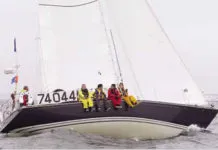
C&C 40 Used Boat Review
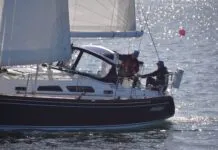
Sabre 386 Used Boat Review

How Does the Gulf Stream Influence our Weather?

Can You Run a Marine Air-Conditioner on Battery Power?

Preparing Yourself for Solo Sailing

Your New Feature-Packed VHF Radio

Practical Sailor Classic: The Load on Your Rode

Anchor Rodes for Smaller Sailboats

Ground Tackle Inspection Tips

Shoe Goo II Excels for Quick Sail Repairs

What Oil Analysis Reveals About Your Engine

An Unusual Sailboat Shines a Light On A Sustainable Future

Is It Time to Get an Electric Dinghy Motor?

Bottom Paint 30-Month Update

Battle of the Teak Cleaners — Snappy Teak-Nu vs. Star Brite

New Seacocks for the Offshore Sailor

Bottom Paint Care

Are E-bikes Worth the Extra Weight and Cost?

How to Handle the Head

How to Select Crew for a Passage or Delivery

Preparing A Boat to Sail Solo

Re-sealing the Seams on Waterproof Fabrics

Waxing and Polishing Your Boat

Reducing Engine Room Noise

Tricks and Tips to Forming Do-it-yourself Rigging Terminals

Marine Toilet Maintenance Tips

Learning to Live with Plastic Boat Bits
- Sailboat Reviews
Cape Dory 30
Our pick of these boats is a cutter-rigged late model with full-width galley and pedestal steering..
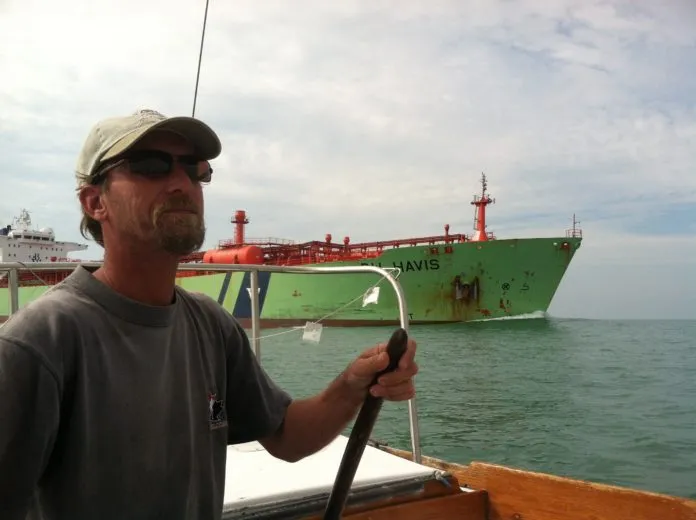
When the Cape Dory 30 entered production in 1976, it was the largest boat in the expanding line of the Taunton, Massachusetts boatbuilder. In 1986, when production ceased, over 350 Cape Dory 30s had been built, and what had been the largest boat in the company’s fleet was one of the smallest.
In 1986, Cape Dory introduced the Cape Dory 30 Mk II, an entirely different boat, designed in-house (rather than by Carl Alberg), longer on the waterline, 1 1/2′ wider, and with a far roomier and more modern interior.
The old Cape Dory 30 was designed as a ketch, with cutter or sloop rigs optional. In the middle of the production run, the more efficient cutter rig replaced the ketch as standard. The ketch remained an option.
The Cape Dory line always consisted of traditional- looking, long-keel cruising boats, and their appeal has been strongest on the East Coast, particularly in New England, a well-known hotbed of sailing reactionaries.
Sailing Performance
No one buys a Cape Dory looking for a flashy speedster. The original ketch rig has a lot of windage, and relatively small, inefficient sails. The rig does, however, give the boat a distinctly “shippy” traditional appearance.
A PHRF rating of about 220 shows the ketch to be a slow boat. By way of contrast, the old original C&C 25 carries about the same rating. The cutter-rigged Cape Dory 30 is about 15 seconds per mile faster.
The Cape Dory 30 was originally equipped with worm gear steering. This type of gear is powerful, foolproof, and requires no steering pedestal in the cockpit. The wheel will also hold the rudder in position without a brake. The disadvantage is that there is almost no rudder feedback, so that it’s hard to tell when the boat is properly balanced. Worm gear steering will not make you a better sailor.
The worm gear steerer is especially compatible with the original ketch rig. Since the mizzen is stepped in the middle of the cockpit, it’s nice to get the steering wheel back aft where it won’t take up any usable space. The top of the steering gear box also serves as a good helmsman’s seat.
With the cutter rig, it became feasible to put a more conventional pedestal steerer in the boat. However, moving the steerer further forward meant that the old steering box—now a storage locker—was too far away from the wheel to be used as a seat.
In practice, you usually sit to the side of the wheel with a pedestal steerer, not behind it. But this re- quires a wheel that is big enough to let you get far enough outboard to see sail trim. Most helmsmen will only sit directly behind the wheel when the boat is under power and they can see straight ahead, with no sails in the way.
The big steering wheel that’s the easiest to use with pedestal steering almost requires a T-shaped cockpit for easy maneuverability. The Cape Dory 30 stuck with the straight bench cockpit seats, and used a fairly small destroyer wheel. Although you don’t need the leverage of a big wheel on this boat, it will make steering less tiring, and there is room between the seats to fit a larger-diameter wheel. It would make it necessary to climb over the seats to go forward, however.
Most owners report that the boat—with either rig—is easy to balance under sail. The percentage reporting difficulty in balancing the boat complain of excessive weather helm on a close reach.
Hard steering when reaching is a common complaint on boats with attached rudders and a lot of rake to the rudderpost. The Cape Dory 30 does have a relatively efficient Constellation-type rudder, even if it is located about 2′ further forward than it would be with a comparable fin keel and spade rudder underbody.
Weather helm when reaching is frequently caused by overtrimming the main. On a boat without a vang, the boom tends to lift quickly as the sheet is eased, and the top of the sail twists off and begins to luff. Thinking they’ve eased the sheet too much, many sailors will at that point overtrim the main, shifting the draft of the sail aft and creating weather helm. Under those conditions, the proper thing to do with the Cape Dory 30 is use mainsheet tension to create a fair leech, then ease the traveler down to keep the whole sail working.
On both rigs, the mainsail is controlled by a traveler over the main companionway.
With the ketch rig, the mast is stepped further forward than the cutter, and the mainsheet attaches to the boom about two-thirds of the way aft, giving reasonable leverage. With the cutter, the mast location means that the mainsheet attaches almost exactly at the boom midpoint, reducing leverage and making the sail somewhat harder to trim.
In either case the traveler location at the forward end of the companionway is out of the way, but it makes installing a cockpit dodger more difficult.
The cutter’s main boom is at a reasonable height, but the taller helmsman should still watch his head when tacking.
With the advent of modern headsail reefing systems, the cutter rig is really superfluous on this boat. The small gap between the forestay and headstay makes it difficult to tack a big genoa, yet you really need a big genoa if this fairly heavy boat is to be properly powered in light air. The double head rig is fine in breezes over 15 knots, but in lighter air it’s much slower than a good number one genoa.
According to owners, the boat’s only sailing weakness is light air. With a lot of wetted surface and an inefficient foretriangle, the boat is simply not going to be fast in very light air. All in all, though, owners say the boat is faster than they expected it to be in all conditions.
With a 40% ballast/displacement ratio, the Cape Dory 30 is reasonably stiff despite the very narrow beam. You can get stability with a lot of ballast down low, or with a lot of beam. The Cape Dory 30 gets it from a lot of ballast, placed low in the hull.
With less weight aloft, the cutter should be slightly stiffer than the ketch.
Both the ketch and cutter rig use simple, untapered aluminum masts, stepped on deck. With a stiff section and double lower shrouds, these rigs are fairly foolproof.
Unlike many builders, Cape Dory put diesel engines in every inboard-powered sailboat they built after 1975. You won’t find an Atomic 4 here.
What you will find, unfortunately, is an engine installation and selection that is somewhat less than ideal.
Because this is a narrow boat with slack bilges, it wasn’t possible to get the engine far enough down in the bilge to be out of the way in a normal installation. Instead, the engine is mounted under the cockpit, using a V-drive. The engine is kept out of the way, but out of sight in this case means poor access for servicing. Getting to the alternator belts for adjustment, for example, requires crawlingunder the cockpit through a locker.
The original engine was a single-cylinder Yanmar diesel rated at 12 hp. This engine is too small for the boat, and single-cylinder engines are notorious for their vibration.
Starting with 1977 models, the Yanmar diesel was replaced with a Volvo MD7A, rated at 13 hp. The Volvo engine has more displacement, and has two cylinders. Nevertheless, some owners still complain that the boat is underpowered with the Volvo diesel.
Despite the long keel, the Cape Dory is reasonably maneuverable under power. The exception is handling in reverse, which according to many owners varies from unpredictable to impossible. This is not a characteristic unique to this boat; it is a fault of most long-keel boats with attached rudders. You learn to act as if reverse were nothing more than a set of brakes—not very good ones, at that.
Other than its location, the engine installation itself is pretty good, with dual fuel filters, 1″ bronze shaft, and oil drip pan under the engine. The fuel tank capacity of 20 gallons should give well over 200 miles range under power with any of the engines.
During the 1983 model year, a switch was made to a two-cylinder Universal diesel. We would definitely prefer a boat with either the Volvo or Universal engine over the original small Yanmar.
Construction
The Cape Dory 30 is solidly built, although there is nothing particularly innovative or unusual about the construction. The hull is a solid fiberglass laminate, the deck is balsa cored. No owners in our survey mention problems with either hull or deck construction.
A number of owners have reservations about the hull-to-deck joint, which is not through-bolted. Other owners mention that there are washers but no backing plates on deck hardware such as lifeline stanchions. Although none report problems either with deck hardware or the hull-to-deck joint, their concerns are valid. Backing plates on deck hardware help distribute loads, and reduce the chance of stress cracks around fittings. Likewise, a through-bolted hull-to-deck connection offers a foolproof mechanical backup should the polyester putty bond between the hull and deck fail. Bolts won’t stop leaks, but a through-bolted joint won’t come apart until the surrounding glass fails.
As in most boats this size, the lifeline stanchions are only 24″ high. This is too low for any real security—the lifelines strike most people just about at knee height, the right height for tripping. There are some bolts through the hull-to-deck joint, since both the lifeline stanchions and chainplates fasten through the inward-turning hull flange. We would, however, prefer to see closely-spaced bolts throughout the length of the joint.
Chainplates are cast bronze lugs bolted through the hull and deck flange. As long as the hull and deck are adequately reinforced—and they are, in this case—this type of installation is fine.
We’ve seen the same general type of chainplates on 40′ boats with Lloyds certificates, so they can’t be all bad.
All Cape Dory boats came with deck hardware— cleats, winch islands, bow fittings, seacocks and chainplates—by Spartan, a sister company to Cape
Dory. This is good stuff that will last the life of the boat and then some. The only disadvantages are that it is heavy, being bronze, and is not very well finished.
Going from burnished to polished finish just about doubles the price of a piece of hardware— polishing is very labor intensive—and on most Cape Dory 30s you’ll find burnished hardware. It’s rugged, though.
There’s a fair amount of exterior teak on these boats, including cockpit coamings, toerails, hatch trim, and eyebrow trim around the cabin on later models. This gives the boat a yachty appearance, but it does increase maintenance.
You could get the Cape Dory 30 in any color you wanted, as long as it was Cape Dory white with a nicely-contrasting tan deck. Several owners report discoloration of the colored portion of the non-skid decks. The non-skid itself is quite functional.
Early boats in this series have an unusual water tankage arrangement. One tank is plumbed to the head sink, the other to the galley.
Since you use a lot more water in the galley than in the head, that tank runs out first. Many owners have replumbed these tanks so that you can use the entire water supply.
Some early boats also have the water tank fills located below, which may be fine for keeping salt water out of the tanks, but can make for a fire drill when trying to fill them without making a mess. On later boats there is a 30-gallon water tank under each main cabin settee, and the system is correctly plumbed.
There are proper seacocks on all fittings below the waterline.
The deck-stepped rigs in both the cutter and ketch are well engineered, as no owners in our survey report any deck deflection or stress cracking in that area.
Unlike a lot of 30-footers, the Cape Dory 30 was designed as a small seagoing boat. For example, it has a reasonable bridge deck, although it is lower than the main cockpit seats and the cockpit coamings.There is also a sea hood over the main companionway hatch.
The main companionway is an unusual design. The vertical part of the companionway is fairly narrow and straight sided—good features in terms of seaworthiness. The sliding hatch and its opening are wider, letting more light and air below.
Relatively few owners in our survey report gelcoat blistering. The only glasswork complaints were gelcoat crazing in an early model, and discoloration of the gelcoat in the hull liner, cabin overhead, and non-skid areas in the deck.
Compared to newer 30-footers, the Cape Dory 30 is cramped below. The boat is more than a foot narrower than the typical cruiser/racer built today, and about 2′ shorter on the waterline. There’s no way around it: this is a small boat.
Within these limitations, the interior layout is pretty good. There are V-berths forward, with a dropin insert to form a double. The forward berths are narrow at the foot.
Ventilation in the forward cabin is provided by two opening ports plus an overhead Bomar aluminum- framed hatch. There are drawers and lockers beneath the berths.
The head compartment utilizes the full width of the boat, the way it should on a boat this narrow. Outboard of the toilet is a hanging locker. Opposite the toilet there is a dresser with sink.
A grate in the head sole for a shower was standard equipment, but the pressure water necessary to use it was an option. If you’re going to spend more than a weekend on a boat, a shower is almost mandatory.
Inexplicably, the head sink and shower drain into the bilge. This is unacceptable. Because of the boat’s low freeboard, the head sink is too low to be plumbed directly overboard if you expect it to drain on port tack. The best solution, although it is somewhat awkward, would be to install a closed sump tank in the bilge. It could be emptied overboard by either a manual or an electric pump. You wouldn’t want your bathroom sink and shower to drain into your basement, would you?
Two opening ports plus a cowl vent in a Dorade box provide ventilation in the head. If it were our boat, we’d also install a small venting hatch or another Dorade box over the head, even though the standard arrangement is better than you find on many larger boats.
The main cabin has settees which double as berths along either side. There are narrow shelves above and outboard of each settee.
Since the water tanks take up most of the volume below the main cabin settees, there is little storage space available in the main cabin.
As in most boats this size, the main cabin table folds down from the forward main bulkhead. It will seat four, although in a somewhat cramped fashion.
In the original layout, the galley aft runs the full width of the boat. On the port side there is a pressurized, two-burner gimbaled alcohol stove with oven.
If you want to stay with alcohol cooking fuel, we recommend switching to a non-pressurized stove such as the Origo. Despite the fact that alcohol fires can be extinguished with water, pressurized alcohol stoves can be dangerous because most people underestimate the volatility of the fuel.
The sinks are aft of the stove, and are somewhat difficult to reach because the slope of the bilge intrudes into the space where you would normally stand.
Opposite the stove there is a good galley dresser containing an icebox, storage bin, and drawers. The icebox drains into the bilge. This is a poor arrangement, since organic matter from the icebox will inevitably contaminate the bilge, even if it is pumped daily. The icebox could either be pumped into the galley sink, or into the sump you install for the head sink and shower.
With this layout, you use the top of the icebox as a navigation table. The lack of a good place to do chart work is a common failing in older designs of this size.
Late in the production run, the interior layout was “modernized” by adding a quarterberth and small chart table. The arrangement takes up a lot of the space that was formerly used for the galley. You get another berth—which you don’t need—at the cook’s expense. We don’t think this layout is an improvement, despite the fact that the navigator gets his or her own workspace.
Headroom on centerline in the main cabin is just over 6′, with slightly less further forward.
Main cabin ventilation is good, with four opening ports—excellent bronze Spartan ports—and an overhead Bomar hatch. We’d add a pair of cowl vents in Dorade boxes on either side of the ventilation hatch. The space is there, and the job is pretty simple. Although the galley has reasonable storage, there is little storage space in the rest of the boat. This makes the boat unsuitable as a long-term cruising boat, unless you want to do a fair amount of modification to the interior.
Joinerwork and finishing detail throughout are of good production boat quality. Since a lot of teak is used for interior woodwork, the boat is quite dark below.
You could brighten this up a lot by finishing the interior with gloss varnish, rather than the standard satin oil finish.
Conclusions
With her narrow beam and short waterline, the Cape Dory 30 is a lot smaller than newer boats of this length and displacement. The boat will have a strong appeal to the traditionalist who places a high value on appearance.
The boats are well constructed, suited for serious coastal cruising, and perhaps for limited offshore sailing.
Cape Dory boats were quite expensive, but they hold their value well. When production began in 1976, the Cape Dory 30 had a base price of about $29,000. By the time production ceased a decade later, the price had almost doubled—but so had the price of just about everything.
Although some might prefer the “shippiness” of the ketch rig, the cutter is both faster and more practical. Some boats were built as sloops, and this would be the best rig of all. Inevitably, the Cape Dory 30 will be compared to the Alberg 30. The Cape Dory 30 is longer on the waterline, wider, heavier, and has a roomier interior. The Cape Dory 30 cutter is slightly faster than the sloop-rigged Alberg 30.
Our choice in a Cape Dory 30 would be a latemodel cutter with full-width galley, Edson pedestal, and the Volvo or Universal diesel. For the money, you get a well-designed traditional boat that is a good coastal cruiser for a couple or a small family. We don’t think the boat is big enough for four adults for anything more than weekend sailing.
If you want the looks of an older boat but the construction details and diesel engine found in newer boats, the Cape Dory 30 is a good choice.
RELATED ARTICLES MORE FROM AUTHOR
14 comments.
Some photos would be useful in an article like this. Remember a photo is worth how many words? Regards
Agree – at least one picture of the entire boat would’ve been appreciated
Good article. very informative
If you’re a sailor you’re proud to show your boat! Where are the photos of this boat???
Pictures would’ve been great
If readers are accessing this story on-line, a quick search for “Cape Dory 30 Mark II” produces 1.7 million images.
…so even less excuse for not putting a couple here… 🙂
Cape Dory apparently ventured into trying to have a little more modern design by producing around 75 or so boats with a fin keel and sloop rig – Intrepid 9m by Cape Dory. Ours was originally outfitted with the Volvo diesel but was at some point changed to a 27hp Yanmar 3 cylinder. Much of the Cape Dory 30 interior description sounds similar. It’s been a slow project for us with much to do.
This article was previously published in the 6th edition of Practical Boat Buying in 2003, and perhaps in earlier editions as well. Originally, the article included a sail plan and line drawing of the layout.
i have the Cape Dory 31. One foot difference makes a big difference in the layout. I love the boat.
I bought a 1978 Cape Dory 30 ketch a few years ago, my first big boat, in the hopes of coastal and some blue water cruising. I appreciate the comments made in the article, there are many good points made. A few comments/questions: -I agree with the discussion of backing the boat; I cannot claim to do it well, especially in crosswinds out of a slip. Nice to know I am not alone. -Not sure I understand why the ketch would be more tender than the cutter; its mainmast is a foot or two shorter with a resulting shorter lever-arm. -It should be mentioned that the ketch has a longer on-deck space than the cutter, making it possible to carry a small dinghy on deck; I’m not sure this would be possible with the cutter. -The ketch allows flexibility in sail handling: I can sail with furling genoa and mizzen with good balance, raising and trimming without leaving the cockpit. This is a real blessing for single handing, of which I do a fair amount. -I have installed a Schaefer furler for the genoa, replacing the much older poorly functioning furler that came with the boat. I can self tack the genoa using the jibboom that came with the boat, or raise a storm jib with the jibboom and self tack with a sail well back off the bowsprit. Again, nice for cruising, single handing, and heavy air. -It probably should be mentioned that the Cape Dorys have internal ballasted molded in keel. This may be an advantage in an older boat since one does not have to worry about aging keel bolts. The 4 foot draft, with long keel and attached rudder is an advantage in places like the Louisiana Gulf Coast with plenty of shallow, quite muddy water. Yes, unfortunately, I know this from experience. -Recent hurricanes have put a number of boats ashore. Friends from Texas have told me that one of their members’ Cape Dorys went ashore losing mast and rigging, but little damage to the hull. Anecdotal, but the hull is thick with good glasswork. -I agree with the assessment of the bronze steering gear that came with the boat. It seems bulletproof and simple. Any assessment as to whether it would work with an autopilot system? -thanks for the article.
How does this boat look like, no photos, Great article, not.
For those not entirely reading the fine article…
“ By Darrell Nicholson – June 14, 2000”
Solid review.
What the cape dory cutter rig really needs is a Bowsprit a rather long one at that. Put a 3-4 ft bow sprit on it move the head stay out to the end and the move the staysail stay to where the head stay was and you then have a far better sail plan and you would increase the displacement to sail area ratio to quite speedy levels. Also the main needs a boomvang. The mast without a bowsprit is still too far forward for an efficient cutter rig. (Ona cutter the mast should really be center of the sail plan. I can see looking at the standard sail plan why it would have excessive weather helm not enough head sail area to overcome the main and over all not enough sail area. Carl Alberg included a small bowsprit on the Cape dory 28 and looking at the design of the 30 most of the extra length was added aft. Of the keel. I would really like to see what a long bowsprit would do (would also help with anchoring as you could get the bow roller further out)
LEAVE A REPLY Cancel reply
Log in to leave a comment
Latest Videos
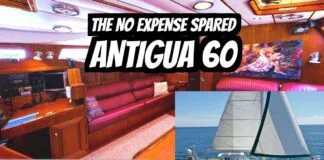
The No Expense Spared Antigua 60 Cruising Sailboat Soolaimon

How To Buy Sails – With Joe Cooper

Bavaria C42: What You Should Know | Boat Tour

Universal Diesel Engines – What You Should Know
- Privacy Policy
- Do Not Sell My Personal Information
- Online Account Activation
- Privacy Manager

Best Single-Handed Bluewater Sailboats

Last Updated by
Daniel Wade
December 28, 2023
Sailing alone in racing or time on the water is a great experience. Finding the best single-handed blue water sailboat for those needs can be a tough task.
Regardless if you have a cruiser or racing sailboat, a single-handed one can offer many opportunities versus larger boats. So what are some of the best ones on the market?
The Hunter Channel 31, J/109, and West Wight Potter 19 are great budget-friendly, single-handed sailboats. Moving up in price, you can look at Hanse 371, Jeanneau Sunfast 3200, and even a Dehler 29. Depending on the size and the amount of features it has will determine what they are worth.
While the budget will play a role in finding the right single-handed boat for you, there are plenty of other factors to consider. These range between comfort, stability, and useful features.
According to experts in sailing, most prefer comfort over price as long as it is justifiable with the amount you are paying. As long as it is not too far over your budget, you could consider a slightly higher-priced boat if it has a few more bells and whistles to make your life easier.
Table of contents
12 Single-Handed Sailboats to Consider
Whether you are planning to cruise around or going out for the day sailing, there are a handful of sailboats to consider. You want to choose one that is best operated alone and would not need additional hands to make it work.
{{boat-info="/boats/rs-sailing-rs-aero"}}
For a fun day out at sea, it is hard to pass up on a quality dinghy . This one, in comparison to other dinghies, is fairly light and takes hardly any time to set up.
The RS Aero is one of the more technologically advanced dinghies for one individual to use. This one in particular has amassed a handful of awards for the best performance overall.
Due to its popularity and quality, these range between $10,000 to $15,000. If you find it any cheaper than that, it could be worth the investment.
2. Beneteau Oceanis 62
{{boat-info="/boats/beneteau-oceanis-yacht-62"}}
If you are feeling a bit adventurous or feel confident in your ability to handle a large boat by yourself, then try out the Beneteau Oceanis 62 . This boat is slightly over 60 feet, so it is recommended that you have all your ducks in a row before setting sail.
Thankfully, the boat was designed with ease of use in mind. So this could easily be operated by one person if they have some experience with it.
If you purchased this one for the family, then you can still have the added benefits of taking people with you. But if you decide you want to be by yourself, that is an option too.
This boat is valued around $600,000, so it is arguably one of the more expensive options for just a single handed sailboat. But if you are looking for a family boat, you are killing two birds with one stone.
3. Hunter Channel 31
{{boat-info="/boats/hunter-channel-31"}}
This British made sailboat debuted in 2001 with a twin keel, making it a great choice for solo sailing. While it has a rich history in racing, the design has gone through slight adjustments over the years to make it a solid cruiser.
With its incredible handling and quick turns, this sailboat has excellent handling. The hull structure allows it to have a low center of gravity and provide it with increased stability compared to other racing boats.
The deck layout, in combination of the self-tacking jib and tiller steering, allow this boat to be one of the best on the market if you can find it.
You can usually sail these fractionally rigged and reef with ease from the cockpit. For around $35,000, you are getting a great deal on a boat that has everything you need.
{{boat-info="/boats/j-boats-j109"}}
If you are not quite ready to venture out alone or want the availability to take people out with you, then the J/109 is a great sailboat to look into. These were first built in 2004, so you should be able to still find them today.
If you decide that you want to take it out by yourself, you could look into going offshore and into areas where other boats have difficulty reaching. You might be able to get it to plane on open water, but it is a little heavy.
With its asymmetric spinnaker, you should be able to jib from the cockpit with light wind. Even in heavier winds, this boat offers great stability.
Due to its high standards of construction and long term stability, these boats are still valued around $60,000. If you can find one a little less for that, it could be a steal.
5. West Wight Potter 19
{{boat-info="/boats/west-wight-potter-19"}}
This boat design has been around since 1979, which prioritized safety and handling. Those factors alone make it a quality solo handling boat.
This sailboat has grown on many over the last three decades. People have probably overlooked it due to its name, but you should definitely check it out if you find one.
The slight design changes over the years have turned this into a tough little boat. It has a Bermuda rigged sloop and can handle various conditions.
With its lifting keel, it allows it to navigate shallow waters. This boat might be one of the more versatile options out there if you plan on sailing in shoal drafts.
For the price, it is hard to beat something less than $10,000. If you are wanting a newer version with upgraded features, you could be spending around $25,000.
6. Hanse 371
{{boat-info="/boats/hanse-371"}}
For a mid-sized cruiser, it will be hard to pass up a Hanse 371 if you come across it. This boat design is geared towards single handed sailing, with a perfect mix of older and newer technology.
It has a furlong and self-tacking jib, along with an autopilot feature making it easy to use for one person. For a boat that was built around 2000, it was well ahead of its time.
Even though the boat is a bit larger than some others for solo sailing, you will have plenty of space to move around. With the large galley and quite a bit of cabin room, you will feel like you are in a mansion.
The look and handle of this boat is favored by many, which is why it still holds its value. You can potentially find ones for sale around $60,000.
7. Jeanneau Sunfast 3200
{{boat-info="/boats/jeanneau-sun-fast-3200"}}
From the first glance at this boat, you can see that it has a traditional look compared to other sailboats. Since it is smaller and lighter, it makes it easy to handle through many conditions.
The boat was originally designed to be a racer, so you have stability and strength in addition to speed. These were built around 2008, but still offer some of the best technology you will find today.
For space, you will have plenty of room just for yourself. There are two double cabins, galley, and a head compartment.
This fractional sloop, along with the keel, can provide easy sailing in either direction of the wind. You can comfortably have the mast around 60 percent to reach a comfortable speed.
This boat is still modern, so you will see these a little bit more often than some others. You will likely find them for about $160,000 but you get all of the latest technology and a boat that is built to last.
8. Tartan 3700
{{boat-info="/boats/tartan-3700"}}
The Tartan 3700 is another quality boat that you can live on and comfortably cross the sea with. Thanks to the self-tacking jib, it allows the boat to be used easily by one person.
This boat was originally designed in the 1970’s, but still has value today. It has been proven to be a great boat to cover long distances and with multiple people on board.
Even though this one might be a little bit older in comparison to other single handed boats, the price still ranges close to $150,000. Rest assured, there is still quality and reliability with this sailboat.
9. Dehler 29
While this boat is not as popular in America, the Dehler 29 is a popular German sailboat. This boat is starting to become popular as more sailors look for single handed boats.
In 1998, this boat earned the honors for boat of the year and sailing boat of the year in the Cruising World Magazine. Since then, it still performs with quality since day one.
Since it is equipped with a tiller, you can steer this boat with ease. This offers one of the best opportunities to steer a boat without having to have an extra set of hands.
For the price, you can still find these on the market for slightly under $60,000. This is what you will pay for top quality German sailboats.
10. Rhodes 19
{{boat-info="/boats/oday-rhodes-19"}}
The Rhodes 19 is another classic style sailboat that many will gravitate to when they see it. Not only is it perfect for solo sailing, but you can have a few people on board if you enjoy family time.
The hull design is meant to be forgiving on the water, allowing it to easily handle heavier conditions. Since day one, this boat’s design has stood the test of time whether you are experienced or a newbie when it comes to sailing.
You can sprit rig this boat or simply use a Bermuda rig to help push you along with the wind. Since it has a low center of gravity, you do not have to worry about stability with this one.
Depending on your location, you can still find these for about $20,000. Assuming it is in good condition, you might find them slightly higher priced.
11. Pacific Seacraft Flicka 20
{{boat-info="/boats/pacific-seacraft-flicka-20"}}
This boat has a strong history of solo sailing , simply because having more than one or two people would be uncomfortable. These were very common around the 1980’s and there were roughly 400 of these built. If you can find one that was built in the late 90’s, that would be your best bet.
The reason this boat deserves some attention is that you can potentially find it for a great price and live on it. This boat is also towable, making it easy to take with you no matter where you go. For just under $20,000, you can find plenty in good condition.
{{boat-info="/boats/vanguard-laser"}}
The Laser is a specific boat that you have probably seen in the Olympics. This small boat is simple and ready to go exploring for solo sailing.
This is arguably one of the most popular single handed boats out there. If you want the simplest option for sailing by yourself, look no further than a Laser.
This boat can use various rig types, so whichever method you prefer. Most use cat rigging since there is no headsail and just one mainsail. It also helps that this boat is easy to set up, making it desirable for solo handlers.
For the price point, you cannot beat $7,000 compared to other single handed boats. Due to its popularity and quality, you might have to pay a little more.
Why You Should Solo Sail
Solo sailing is an experience like no other and even replicates similar adrenaline rushes in other sports. If you are not seeking the thrill, there are boats drained to take it a little bit slower on the water.
Regardless of your skill level, you should consider the experience at least once in your life. The beautiful thing about this is, it does not have to be the perfect boat to get it done.
There are even plenty of sailors that have sailed on much larger boats or ones that were designed for more people. It all depends on the adventure you are trying to seek, but there is clearly not another like it when sailing on your own.
Features to Look for in Single-Handed Boats
When solo sailing, there are plenty of features that can separate one boat from another. These can make a big difference in how your adventure goes for the day.
The conditions at sea are often unavoidable and something that everyone has to deal with. Whether you are solo saling or with a crew, everyone has to be aware of tough conditions.
If you sail alone, you are required to do everything in order to make it back safely. Having something with an automation system will be huge for solo sailors.
If you have a quality boat, the next best thing would be automation systems on board to help your life sailing much easier. Some of these systems include autopilot, electric windlass, roller furling, and even a radar.
Other sailors might want lines that run to the aft, a wind vane, or a hydraulic system for the bow or stern. Basically anything that you can do with a click of a button to reduce manual labor.
While this is an obvious option, you do not want to forget about stability. No matter how fast the boat is or how many cool features it has, those will be useless if you have issues with handling.
You want a boat that has wide beams and shorter waterlines. While this limits some speed, that is a much better trade off than having nothing at all.
Easy to Use
When picking out your single handed sailboat, you want one that is easy to use. If there are too many features that are required to get it going, you either need more experience or that boat is not right for you.
Try finding one that only requires a few steps in comparison to other ones. You might have to pick one that is a bit smaller in order to get used to it all, which is all you really need since your are by yourself.
Many sailors will have their preferred sails when going out on the water. A unique sail design that you could look for is the Bermuda sail with a gaff sail.
This allows you to have more sail area on a shorter mast. It also allows you to have better control and less heeling force that is common for longer sails.
It does make sense to choose the one that is right for your boat and what is most comfortable to you. After you find the right boat for you, you should strongly consider the sails it has.
Rigging Type
When it comes to solo sailing, the gaff rig is one of the best rig types. Even though the Bermuda is the most common, you lose some windward capabilities since it is lower.
The gaff rig makes the most sense because it is easier to use and has the best downwind performance. Each sailor will have their preferred rig type, but in solo sailing, the gaff stands out the best.
Price Point Makes a Difference
You do not have to break the bank when deciding what boat is best for solo sailing. There are boats that can fit within any budget, and you just have to know what you are looking for.
Just because a boat is priced over $100,000, does not guarantee that it is the best on the market. Depending on the brand, how many features it has, and how big the boat is will determine the price.
Some of the best single handed sailboats are priced less than $20,000. It all depends on the type of adventure you are seeking and how much money you are willing to spend.
Related Articles
Best Bluewater Pocket Sailboats
Best Bluewater Sailboats Under $100k
Best Bluewater Sailboats Under 24 Feet
I've personally had thousands of questions about sailing and sailboats over the years. As I learn and experience sailing, and the community, I share the answers that work and make sense to me, here on Life of Sailing.
by this author
Best Sailboats
Most Recent

What Does "Sailing By The Lee" Mean?
October 3, 2023

The Best Sailing Schools And Programs: Reviews & Ratings
September 26, 2023
Important Legal Info
Lifeofsailing.com is a participant in the Amazon Services LLC Associates Program, an affiliate advertising program designed to provide a means for sites to earn advertising fees by advertising and linking to Amazon. This site also participates in other affiliate programs and is compensated for referring traffic and business to these companies.
Similar Posts

Affordable Sailboats You Can Build at Home
September 13, 2023

Best Small Sailboats With Standing Headroom

Best Bluewater Sailboats Under $50K
Popular posts.

Best Liveaboard Catamaran Sailboats

Can a Novice Sail Around the World?
Elizabeth O'Malley
June 15, 2022

4 Best Electric Outboard Motors

How Long Did It Take The Vikings To Sail To England?

10 Best Sailboat Brands (And Why)
December 20, 2023

7 Best Places To Liveaboard A Sailboat
Get the best sailing content.
Top Rated Posts
Lifeofsailing.com is a participant in the Amazon Services LLC Associates Program, an affiliate advertising program designed to provide a means for sites to earn advertising fees by advertising and linking to Amazon. This site also participates in other affiliate programs and is compensated for referring traffic and business to these companies. (866) 342-SAIL
© 2024 Life of Sailing Email: [email protected] Address: 11816 Inwood Rd #3024 Dallas, TX 75244 Disclaimer Privacy Policy


BLUEWATER SAILING YACHTS QUALITY CRUISING SAILBOATS FROM THE WORLD’S TOP BUILDERS.
BLUEWATER CRUISING SAILBOATS FOR SALE

2019 Outbound 56
Specifying and building Outbound 56 BAREFOOT was a labour of love for her owners. They wanted to build the best quality and most practical cruising yacht that they could sail easily, as a couple, and that would carry them and their young children in safety and comfort, even to remote areas. The yacht is a very highly specified and much improved version of the well-known Hylas 56. Even after delivery the owner continued to improve and upgrade the yacht – including changing out the main engine. No cost has been spared to produce this wonderful yacht. With her hydraulic in-mast furling main, hydraulic furler to both of the headstays, electric furling gennaker, electric sheet winches - all controlled at the cockpit – she may be sailed single-handed (and has been). The interior provides a delightful aft “stateroom”, a double cabin forward and a versatile third cabin that may be used as a single or double and serves as a stowage area and workbench.

1988 Sparkman & Stephens Custom 50
The Stephen Custom 50 was conceived by the renowned yacht designers Sparkman & Stephens who have designed and built some of the worlds leading cruising and racing sailboats. They did not miss the mark with this 1988 classy cruiser. This stable yacht is designed and optimized for long term cruising and is a true blue-water sailboat. A solid glass hull and full skeg make Brizo a smooth ride even in rough seaways and give assurance. Built at the Queen Long yard in Taiwan, a precursor to the fabled Hylas yachts, her build quality is unquestioned. The quality craftsmanship and fine joinery is apparent throughout the interior of this well-conceived design. A deck saloon and a three-cabin layout make this yacht perfect for cruising couples or families. If you are seeking a boat that can carry you far and wide with speed, safety, and comfort, Brizo is a must see.

2006 Oyster 56
Renown as one of the world leading sailboat builders, Oyster is the epitome which other boats strive to measure themselves against. Ambrosia a great example of quality, function and form. These deck saloon boats boast bright comfortable interiors, practical sail handling from the helm and rigid construction. A perfect family boat or couples cruiser this boat is optimized for long term cruising in comfort and style.

2014 Bestevaer 66 Custom
A very unique yacht that is ready to sail the world for new adventures. Anabel is a very seaworthy yacht that has been built for unlimited cruising and a unique design which is totally “Custom built”. Only one owner from new. Built in the prestigious KM shipyard in Holland and designed by Dykstra Naval architects, it is made to the specifications of its owner who is a very experienced sailor. All on this yacht is thinking of safety, seaworthiness but not leaving aside the maximum comfort it provides for life onboard. There are no other boats like this on the market this is the reason for its customization.
All Bluewater Cruising Sailboats For Sale
- Little Harbor
- Robert Perry
- Sparkman & Stephens

2020 Outbound 56

2012 Southerly 57 RS

2009 Tartan 5300

2009 Outbound 44

2006 Outbound 46

1999 Marten Custom Bill Tripp 72

1993 Robert Perry Custom 63

1990 Little Harbor 59

1989 Windship 60 Cutter

1989 Little Harbor 54

1988 Little Harbor 46

1983 Mason 53
Featured bluewater sailboat brands.

HYLAS COLLECTION
The premier collection of pre-owned Hylas bluewater sailing yachts that are currently available on the market. Collection Yacht brokers have sold more Hylas sailboats in the last decade than all other yacht brokerages combined.
View Hylas Collection

OYSTER COLLECTION
Oyster is one of the world’s top bluewater cruising sailboat brands. Built in the UK, Oysters are finely crafted seaworthy yachts that capable of ocean passages and circumnavigation, with their most popular models being in the 50-70ft range. The Oyster Collection features current Oyster yachts for sale as well as videos, reviews, and guides.
View Oyster Collection

PASSPORT COLLECTION
Built to meet the style and taste of the American sailing market, Passport yachts are admired worldwide for their hand-crafted quality, proven passage making abilities, and well-thought out designs. While the award winning Passport 545 is perhaps the most popular model, the entire line is built to the same standards and respected for its sailing performance, fine interior woodwork, and beautiful detailing inside and out.
View Passport Collection
Bluewater Cruising Sailboat Reviews, Guides, & News
Passport 545 Aft Cockpit Walkthrough Video
Passport yachts gives us a closer look at the interior and exterior of the Passport 545 Aft Cockpit sailboat.
Promo Video of the All New Oyster 565
A great promo video that Oyster has released highlighting features of the all new Oyster 565.

Oyster 725 Review
The 725 was built, as many Oysters are, to sail anywhere her owners wish to go. She is the first boat in the range to have exceptional and dedicated crew quarters.

Oyster 625 Review
The Oyster 625 is a powerful sailboat that can be handled by an experienced couple but also has ample space for a captain and crew if that is the desired cruising mode.
OYSTER YACHT SALES EXPERTS
Collection Yachts, based in the yachting capital of the world, Fort Lauderdale, is proud to represent buyers and sellers of Oyster Yachts. Traveling with clients across the globe to find the best Oyster Yacht has resulted in long lasting relationships and many sales. Like Oyster, Collection Yachts provides top quality service for as long as a client owns their Oyster.
Previously Sold Models

DISCOVER THE DIFFERENCE
Outbound feature.
FEATURED BRAND
Boat Search
Yacht search looking for a specific boat.
We Can Help - At Collection Yachts, each of our yacht brokers specialize in specific segments of the market and have in-depth knowledge of market pricing and availabilty. Tell us what you are looking for and we can share all possible options that meet your criteria, as well as notify you as soon as new listings become available.
Request More Info
Send a message for more information about this yacht.
954-951-9500
Better Sailing

Best Sailboats Under 30 Feet
Small sailboats are attractive for many reasons, one of them being is that they are not as expensive and out of your budget. They are also great for learning how to sail as they are easily maneuverable. However, sailboats around the 30 feet mark provide the best of both worlds as they are both great and easy for sailing but are also big enough for you to spend a few days onboard for a weekend sailing trip, for example. If you are looking to buy a sailboat that will fit this bill, this list of the best sailboats under 30 feet with the amenities available in a large vessel.
Here are the best sailboats under 30 feet in no particular order.
The Hunter 27 is one of the most popular sailboats under 30 feet and has the numbers to prove it with over 2000 of these boats sold. The Hunter 27 is a series of sailboats, built by Marlow Hunter in Florida, USA, since 1974. Variations of the Hunter 27 are still being produced today. This sailboat is great under sail but is also powered by a 14 HP Yanmar engine. If you are looking for a small, affordable sailboat that can accommodate a couple or a small family for a few days out on the water, then look no further than a Hunter 27. Finally, you can find used Hunter 27 in good condition from the early ’80s for around 10k and newer models from the 2010s’ for up to 50k.

It is a comfortable and speedy sailboat with ample space below the deck. It is open and airy. Named after its designer, Alan Andrews, he is known for creating fast race boats and lights. This is a 28-footer sailboat that is definitely suited for club racing. It has a galley, 6 berths, head, and nav area. This boat is so spacious that you would forget that this is a sailboat under 30 feet. It has a retractable keel, which makes it easy to launch and haul. This ensures it to be a racer as well as a daysailer. Finally, a used Andrews 28 in good condition is going for around $25,000-40,000.
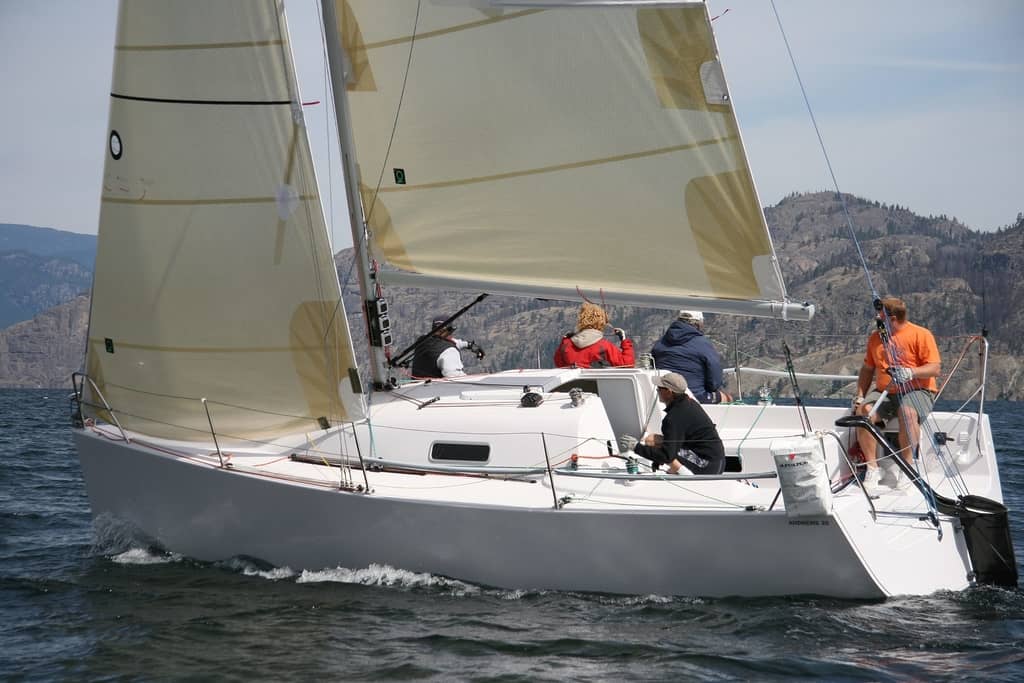
This is a multi-aspect sailboat that tries to bridge a gap between a family, comfortable, safe, and competitive racer. It is done quite well in doing so. This sailboat was able to win the 1970 IOR North America Half-Ton Cup, which proves that it not only has the looks but speed too. Speed is not the only strength of the ranger 26 as it also has a spacious cockpit which is over 7 feet. It has a good balance of cabin height and freeboard, giving it a great profile that hasn’t been sacrificed for standing headroom. Also, the Ranger 26 is one of the largest trailable sailboats. Finally, a used Ranger 26 from the 70s’ in good condition is going for around $10,000-15,000.

>>Also Read: Best Sailboats Under 100k
This sailboat is one of the most innovative and unusual boats in the whole bunch. It has a contemporary profile topside and also an inviting floor plan below the deck; this boat is both comfortable and stylish. The Etap uses a double hull construction method that makes the ship almost unsinkable. This sailboat has 6 berths, a nav area, and a galley, but you will not feel crowded in the back. The back area is equipped with many hatches and ports that make extend the space. Finally, a used Etap 28s in good condition is going for around $20,000-60,000 depending on the age of the boat.

>>Also Read: Etap 24i Review
This boat came started its production in the year 1971, and it was an instant success in the local racing scenes. As this is a modest 27-footer, the Newport 27 has a great spacious interior and has over 6 feet of standing headroom. It has 4 berths, nav station, galley, and head. It has all the amenities that you will find in a bigger boat but in a compact package. This boat is quick in light air; however, the tiller steering starts to get out of control once the breeze increases and the weather leads to end your sail early. Finally, a used Newport 27 from the 70s’ or 80s’ in good condition is going for around $6,000-11,000.
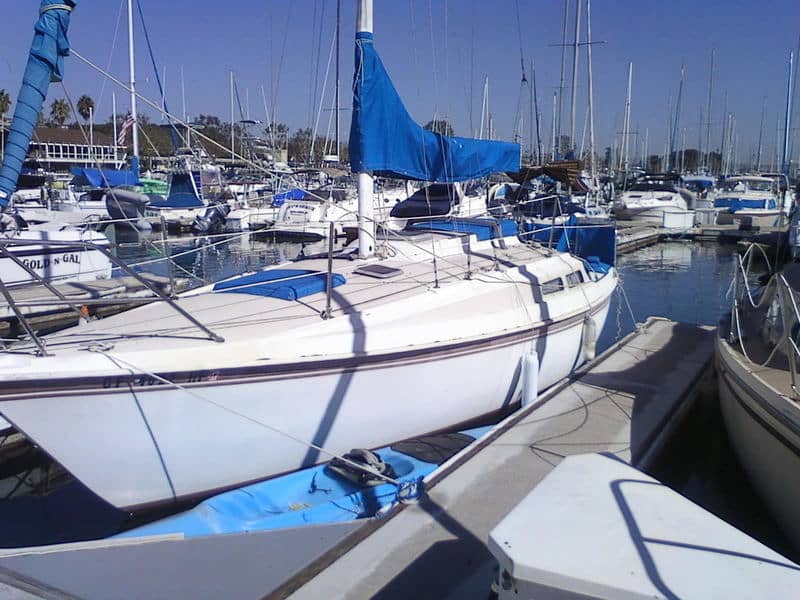
Catalina 275 Sport
The Catalina is known for their large cruising boats, but they also have small boats too. The Catalina 275 offers both great performance and an enjoyable sailing experience packed on a 27’6 trailable sailboat. This boat has a hand-laminated fiberglass hull and is extremely versatile. Like most boats that are built by Catalina, this boat has a huge self-bailing cockpit. It also a nice saloon below deck, which transforms into a comfortable v berth. Also, it has a nice galley with a big cooler drawer to pack your essentials for your sailing trip. The standard equipment has a tiller extension and hiking straps. This boat will convince you that you do not need a sailboat over 300 feet to enjoy a nice weekend sailing adventure. A new Catalina 275 starts at around $75,000, and a recent-year used one for around $60,000.

>>Also Read: Best Sailboats to Live On
Catalina 22 Capri and Catalina 22 Sport
The Catalina 22 is extremely comfortable, safe at sea, and easier to handle and maintain than any boat in its class. The beautiful deck profile is flat across the stern. It has wider cockpit curves for optimum sailing comfort during and after sailing. These are very popular trailer sailers that are widely used in both ocean sailing and lake sailing, and daysailors swear by both models. The Catalina 22 was first built in 1969, and it is still being produced in the US. The Catalina 22 is one of the most produced boats in its size range and has achieved huge commercial success. Finally, you can purchase a new Catalina 22 starts at around $25,000, but since this model has been around since the 60s’ you can still pick an early-year model up from the 70s’ for as low as $3,000.
Island Packet 27
This is an American-made sailboat first built in the 1980s’. The Island Packet 27 is a recreational keelboat made out of fiberglass, with beautiful teak trim and holly cabin sole plywood. It is a Cutter-rigged sloop, with a spooned raked stem, a vertical transom, a keel-mounted rudder, and a full keel. It has a displacement of 8,000 lb and carries 3,000 lb of ballast. Keep in mind that the Packet 27 is a cruiser and not suitable for racing. The broad beam gives an unusually spacious interior for a sailboat under 30 feet. This boat sails very well, it has a big boat feel to it, it is very solid, and you won’t get thrown around in it; what else do you need? Finally, a used Island Packet 27 in good condition is going for around $30,000-45,000 depending on the age of the boat.

>>Also Read: Best Pocket Cruisers Under 20 Feet
This boat was first introduced in the year 1969; the Balboa 26 continues to dominate in the budget-friendly cruisers. This boat is heavy and sturdy; the boat’s stress points are reinforced. The cockpit can take 4 adults at a time. It is self-bailing, making sure that the sailors remain dry. This beautiful sailboat is only 26 feet. Still, the balboa 26 still has room for a double berth, a freshwater pump, galley with a stove, and an optional V-berth or marine head. It can adjust five people for sleeping, but the ideal number would be two or three. When the Balboa is under sail, it is maneuverable and fast. It will also prove handy in the heavy breeze when the weather helm increases. Finally, a used Balboa 26 from the 70s’ is going for around $3,000-6,000.

Cape Dory 28
The teak accents and sleek lines of the Cape Dory 28 is an eye-catcher; the performance of this boat is also remarkable. This boat comes with almost all the amenities a bigger boat is equipped with. It comes with 2 settees, V-berth, and ahead. This boat is sound, safe, and comfortable while being capable of speed. The Cape Dory 28 is quick in light wind and capable and sturdy in heavy air. This boat deserves its praise when it comes in off the wind. It has a balanced helm and also the ability to cut through chop and still be able to tack easily. Finally, a used Cape Dory 28 in good condition is going for around $20,000 depending on the age of the boat.
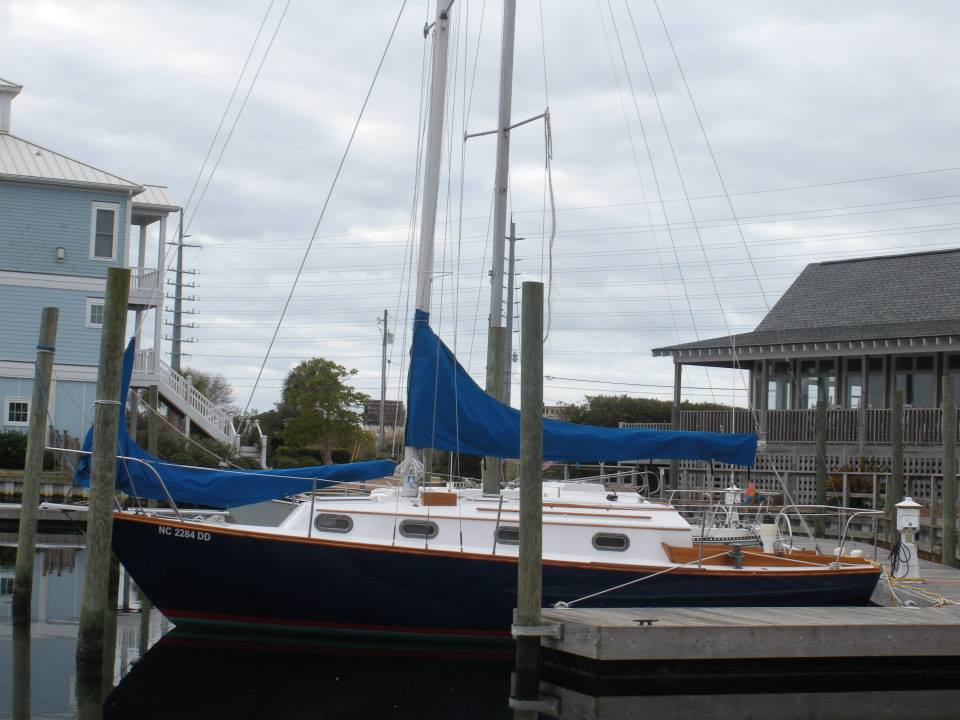
Islander Bahama 28
While this remains an eye-catcher, along with the 5-foot-6inch draft and with the 3,300 pounds of ballet, this boat sails swiftly and beautifully while responding quickly to the helm. This boat is inspired by the International Offshore Rule; this boat is unusually wide and offers stability in the breeze without sacrificing the lines and sheer, which makes it attractive. The Bahamas below its deck has plenty of berth and storage space with a galley complete with stove, sink, and icebox. Finally, a used Cape Dory 28 in good condition is going for around $9,000-15,000 depending on the age of the boat.
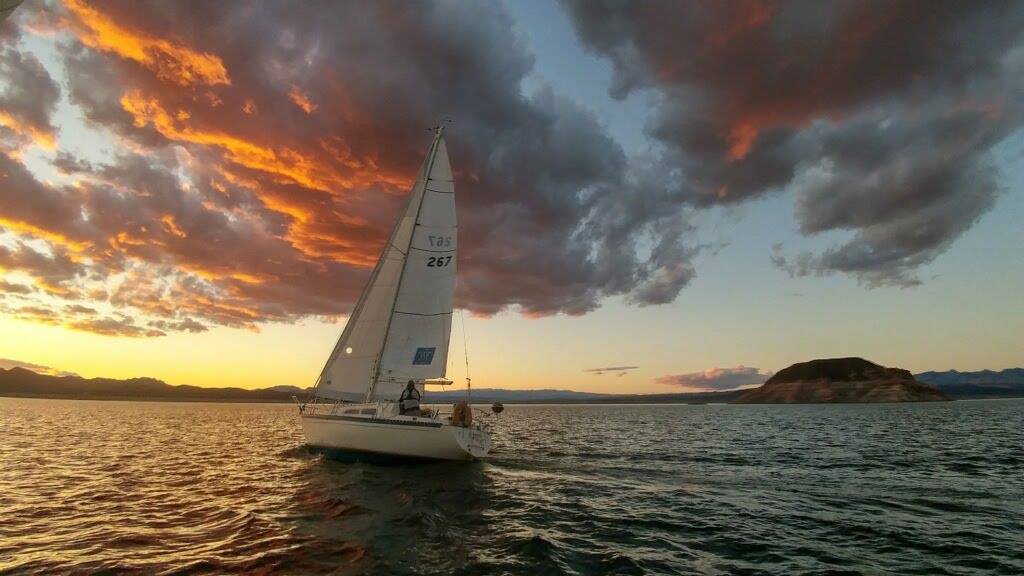
Contessa 26
This boat was released in the year 1965, and it then and there proved to be a strong, lightweight cruise boat. This boat has been proving itself since its first sail and a great choice for two people. Even though the boat is sturdy, the upwind came sometimes disturbs the direction. This boat does have much standing headroom, but it performs well as a daysailer. Finally, a used Contessa 26 in good condition is going for around $10,000 depending on the age of the boat.

Final Thoughts
Sailboats under 30 feet are great because they are affordable and provide the best of everything. Almost all of them handle great, they are easy to maintain and provide all the necessary amenities for trips up to a few days long. Sailboats under 30 feet are not ideal for passages but make if you are willing to increase your budget and go a little bigger then these are the best small sailboats for circumvention .
Remember, if you are looking for a small sailboat under 30 feet for your summer or weekend sailing expeditions, then any of the above mentioned will do the trick.
Peter is the editor of Better Sailing. He has sailed for countless hours and has maintained his own boats and sailboats for years. After years of trial and error, he decided to start this website to share the knowledge.
Related Posts

The Ultimate Guide to Choosing the Best Fishing Line for Trolling

Lagoon Catamaran Review: Are Lagoon Catamarans Good?

Best Inboard Boat Engine Brands

Are O’Day Sailboats Good? A Closer Look at a Classic Brand
- Buyer's Guide
- Destinations
- Maintenance
- Sailing Info
Hit enter to search or ESC to close.

IMAGES
VIDEO
COMMENTS
The 10 best bluewater boats. 1. Westsail 32. Photo credit: SailboatData.com. The Westsail 32 is one of the most iconic bluewater cruisers and 19 have set out to cross the Pacific in the PPJ rally since 2009. In 1973, this small cruising sailboat garnered a 4-page spread in Time magazine.
Table of contents. 1. Cape Dory 30. If you're looking for a quality, affordable bluewater sailboat, the Cape Dory 30 is definitely worth a look. This boat has been cruising the world's oceans for over 30 years and has a well-deserved reputation for being sturdy, reliable and easy to sail.
She also grants more space down below than most 30 foot small bluewater sailboats offer. The charm and sturdiness of this little cruiser have to be her strong points. Jordan and Randy from YouTube channel Learning the Lines specialize in boat reviews. They think the Baba 30 embodies the "go small, go now" mentality popularized by Lin Pardey.
The best bluewater sailboats under 24 feet are the Pacific Seacraft Dana 24, Norseboat 21.5, Catalina 22 Sport, Pacific Seacraft Flicka 20, and West Wight Potter 19. These sailboats have ample space for a couple and even a moderately-sized family along with all the amenities you may need. A roomy cabin, galley, and settees are necessary to go ...
Solo bluewater sailboats are designed to be sailed by a single person, making them ideal for solo circumnavigation or long-distance cruising. You can get the Contessa 32 and Westsail 32 for as little as $30,000. The maintenance and repair costs of the seven boats range from $5,000 to $50,000 per year. Marina fees and insurance can range from ...
Allures 51.9 price: €766,000. The Ovni 370 is another cunning new aluminum centreboard offering, a true deck saloon cruiser for two. The designers say the biggest challenge was to create a ...
Blue Water Boats. This collection of capable blue water boats features time-tested sailboats with rich histories. Bluewaterboats.org built an encyclopedia of offshore sailboats for the sailing community. It contains a thorough summary of the history, details of the design and construction, and sailing characteristics on 99 sailboats.
To give you a simple answer to your question, the best bluewater sailboats under $100K include the Allied Princess 36, Cabo Rico 38, Celestial 48, Freedom 36, Corbin 39, Tayana Vancouver 39, Nordic 40, Hans Christian 38, Hinckley Bermuda 40, Prout Snowgoose 37, and Valiant 40. Bluewater sailing needs the best sailboats - these need to be ...
Sailboat Keel Types for Blue Water Sailing. A keel is a fin-like blade found at the bottom of a sailboat. It supports the ballast and helps to control and steer the boat. ... Alberg 30. This 30-foot traditional sailboat could take you anywhere. Alberg is notable for its narrow beams, long overhangs, and full cutaway keel with its directly ...
With these considerations in mind, here are my picks—five top choices for affordable bluewater cruising sailboats (in alphabetical order). Caliber 40 LRC. The Caliber 40 design appeared in 1991 and through its evolution into the 40 LRC, remains a very attractive cutter. It has a fully encapsulated, elongated fin keel, and the ballast to ...
Oyster 56. In the ranks of dream bluewater cruisers, Oyster is right up there. The 56 is the British yard's most popular boat; small enough to be handled by two people, big enough to cross an ocean quickly and comfortably, yet not so large or complex as to need a full-time pro crew.
Best bluewater cruisers of 2022. The new flagship Allures 51.9, for example, is a no-nonsense adventure cruising design built and finished to a high standard. It retains Allures' niche of using ...
Top Ten Affordable Bluewater Cruisers (according to SailFarLiveFree.com) 10. CSY 33: With a production run of only 57 boats, it's not surprising that many people aren't familiar with CSY's smallest sailboat. Her swoopy sheerline and sharp bow beckon me.
A truly fun boat to sail, the First 30 is a Porsche among the fleet of family cars. www.beneteauamerica.com. ... The design is based upon a 30-foot yacht named Babe that was designed by the legendary Olin Stephens in 1935 and used as a coastal racer and weekend cruiser. ... Blue Water Sailing is now in its 22nd year of publication and reaches ...
14. Practical Sailor tester Mike Collins guides the Cape Dory 30 "Skimmer" in the ship's channel on Tampa Bay. (Photo courtesy of Mike Collins) When the Cape Dory 30 entered production in 1976, it was the largest boat in the expanding line of the Taunton, Massachusetts boatbuilder. In 1986, when production ceased, over 350 Cape Dory 30s had ...
10.83 ft / 3.30 m: Displacement: 10,200.00 lb / 4,627 kg: Ballast: ... 30 to 40 indicates a moderate bluewater cruising boat; ... Designed to determine if a boat has blue water capability. The CSF compares beam with displacement since excess beam contributes to capsize and heavy displacement reduces capsize vulnerability. The boat is better ...
The Hunter Channel 31, J/109, and West Wight Potter 19 are great budget-friendly, single-handed sailboats. Moving up in price, you can look at Hanse 371, Jeanneau Sunfast 3200, and even a Dehler 29. Depending on the size and the amount of features it has will determine what they are worth.
Bluewater preowned sailboats for sale by owner. Bluewater used sailboats for sale by owner. Home. ... Sailboat Added 30-Nov-2022 More Details: Bluewater Ingrid 38 Ketch: Length: 38' Beam: 11' Draft: 6' Year: ... 25' O'Day 25 Foot ODay Scituate, Massachusetts Asking $6,000. 28' Cornish Crabbers Mark II
OYSTER COLLECTION. Oyster is one of the world's top bluewater cruising sailboat brands. Built in the UK, Oysters are finely crafted seaworthy yachts that capable of ocean passages and circumnavigation, with their most popular models being in the 50-70ft range. The Oyster Collection features current Oyster yachts for sale as well as videos ...
The Hunter 27 is one of the most popular sailboats under 30 feet and has the numbers to prove it with over 2000 of these boats sold. The Hunter 27 is a series of sailboats, built by Marlow Hunter in Florida, USA, since 1974. Variations of the Hunter 27 are still being produced today. This sailboat is great under sail but is also powered by a 14 ...
29.96 ft / 9.13 m: LWL: ... 30 to 40 indicates a moderate bluewater cruising boat; 40 to 50 indicates a heavy bluewater boat; over 50 indicates an extremely heavy bluewater boat. Comfort ratio = D ÷ (.65 x (.7 LWL + .3 LOA) x Beam^1.33), where displacement is expressed in pounds, and length is expressed in feet. ...